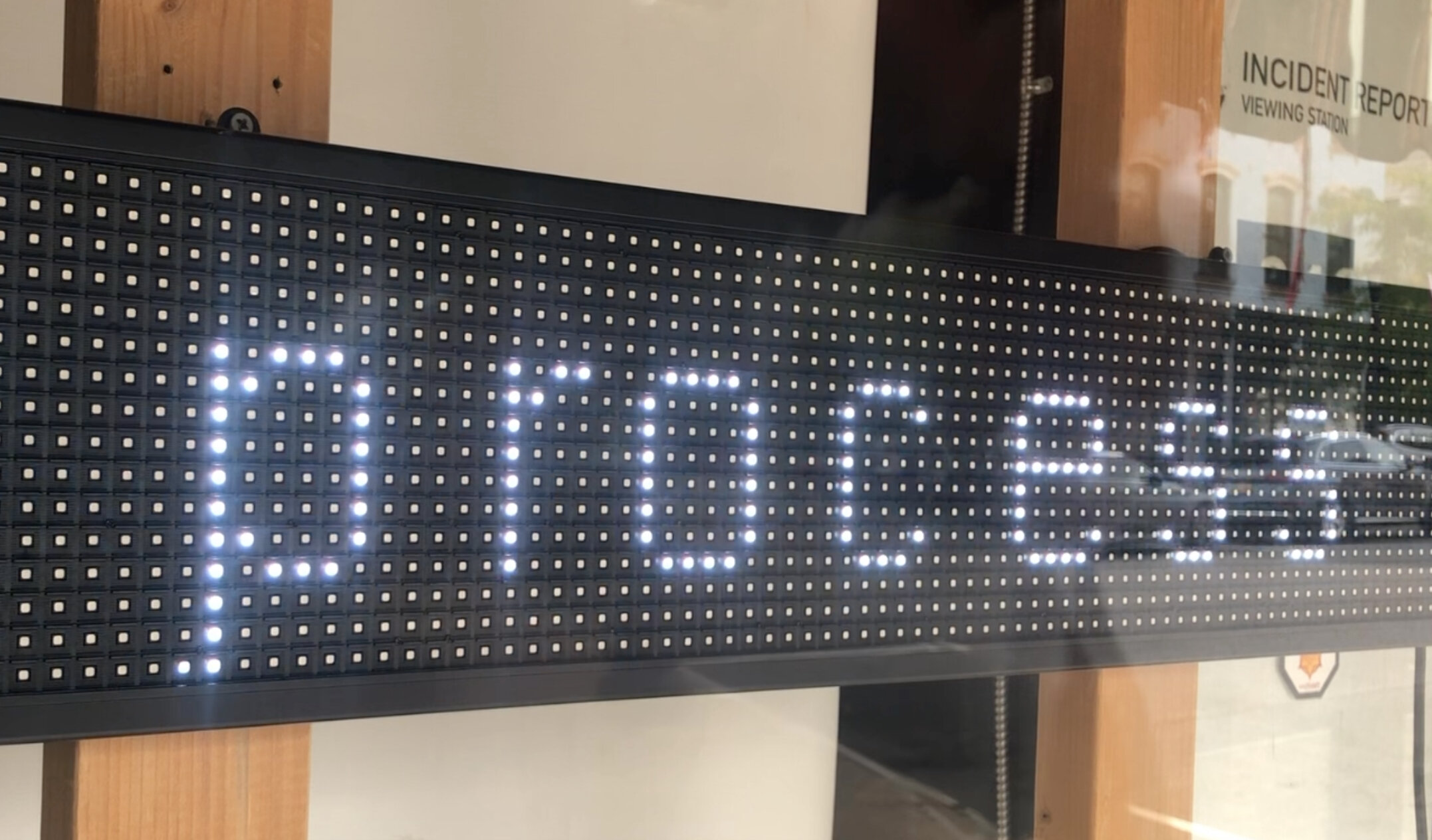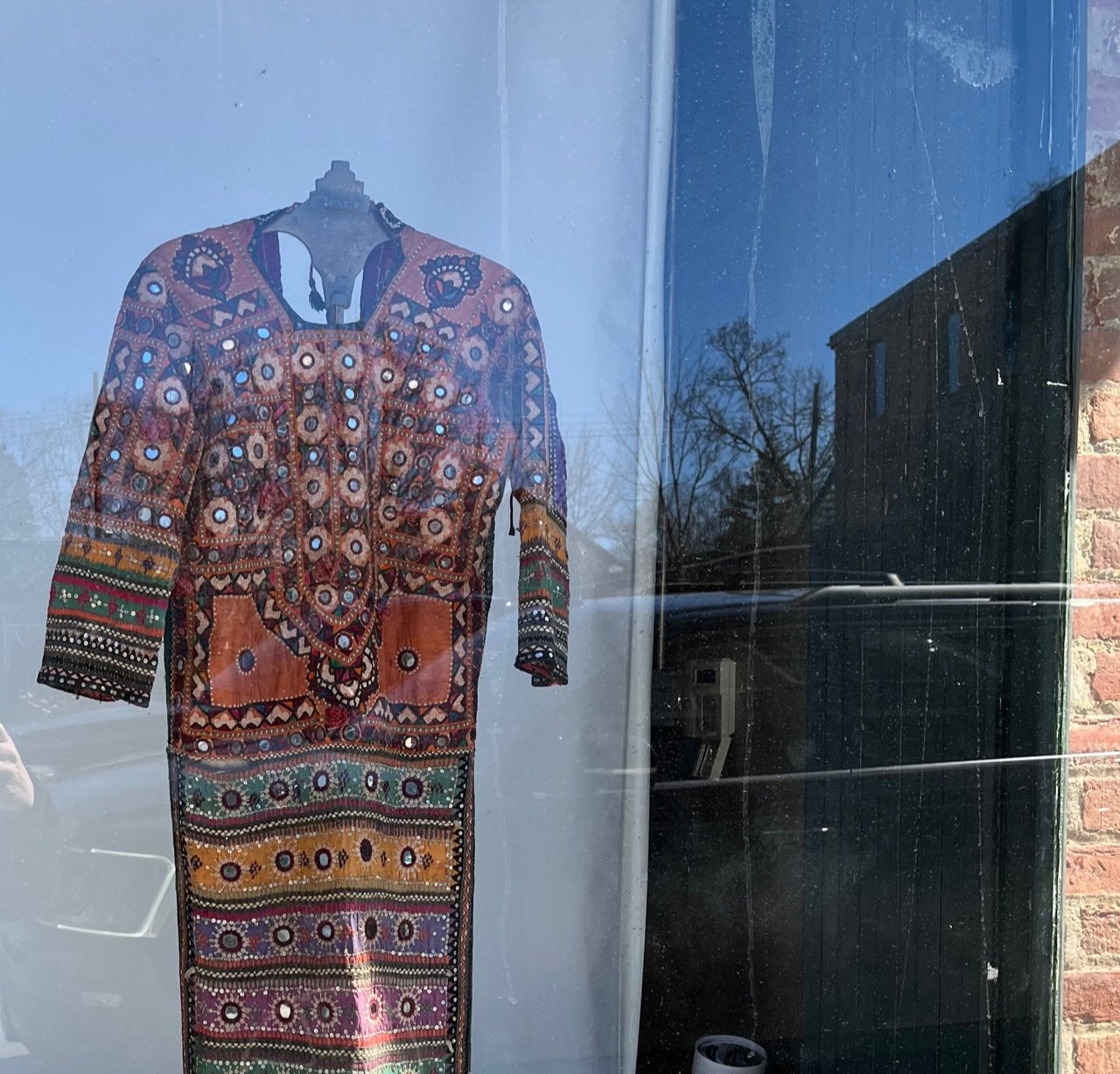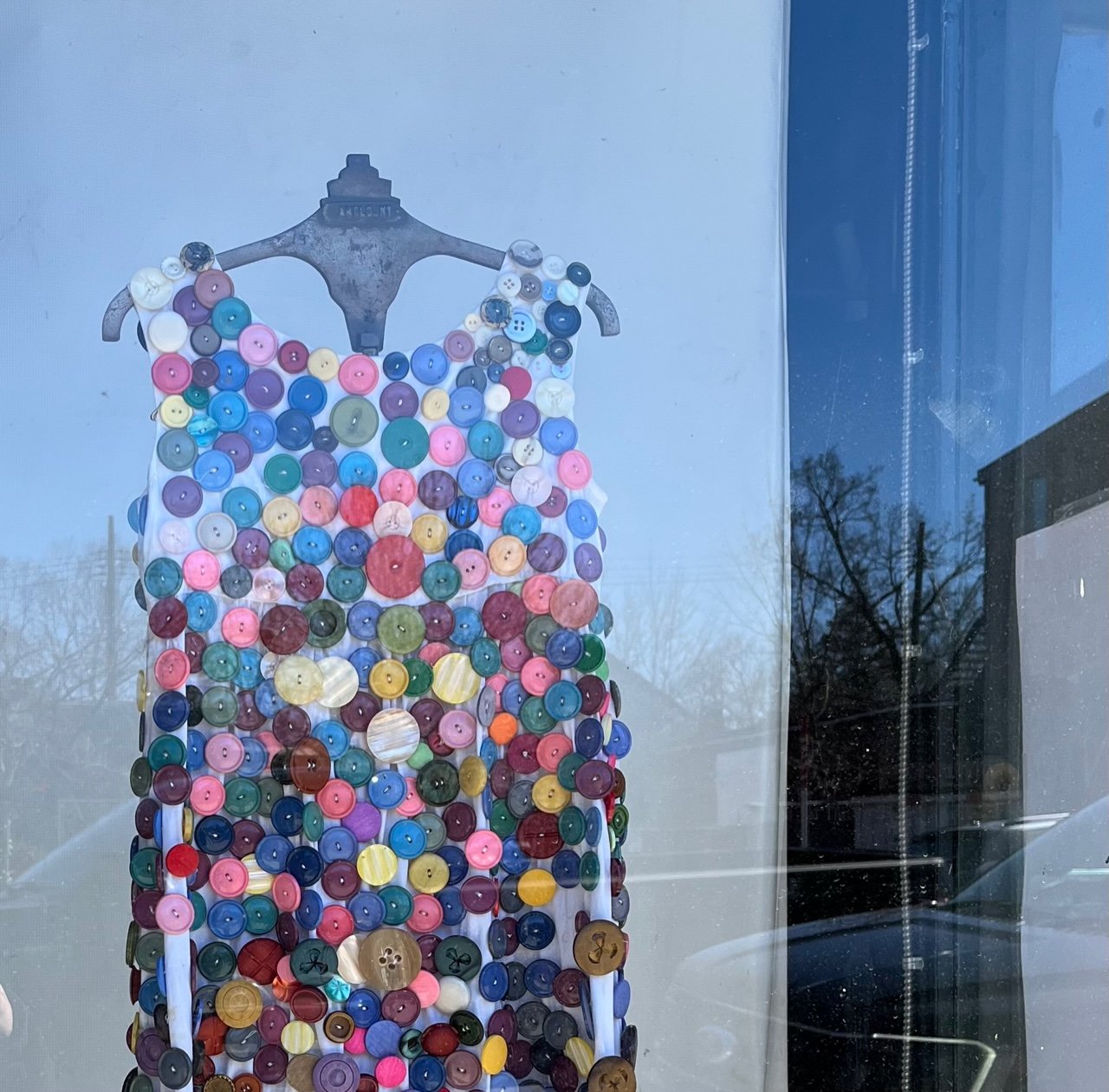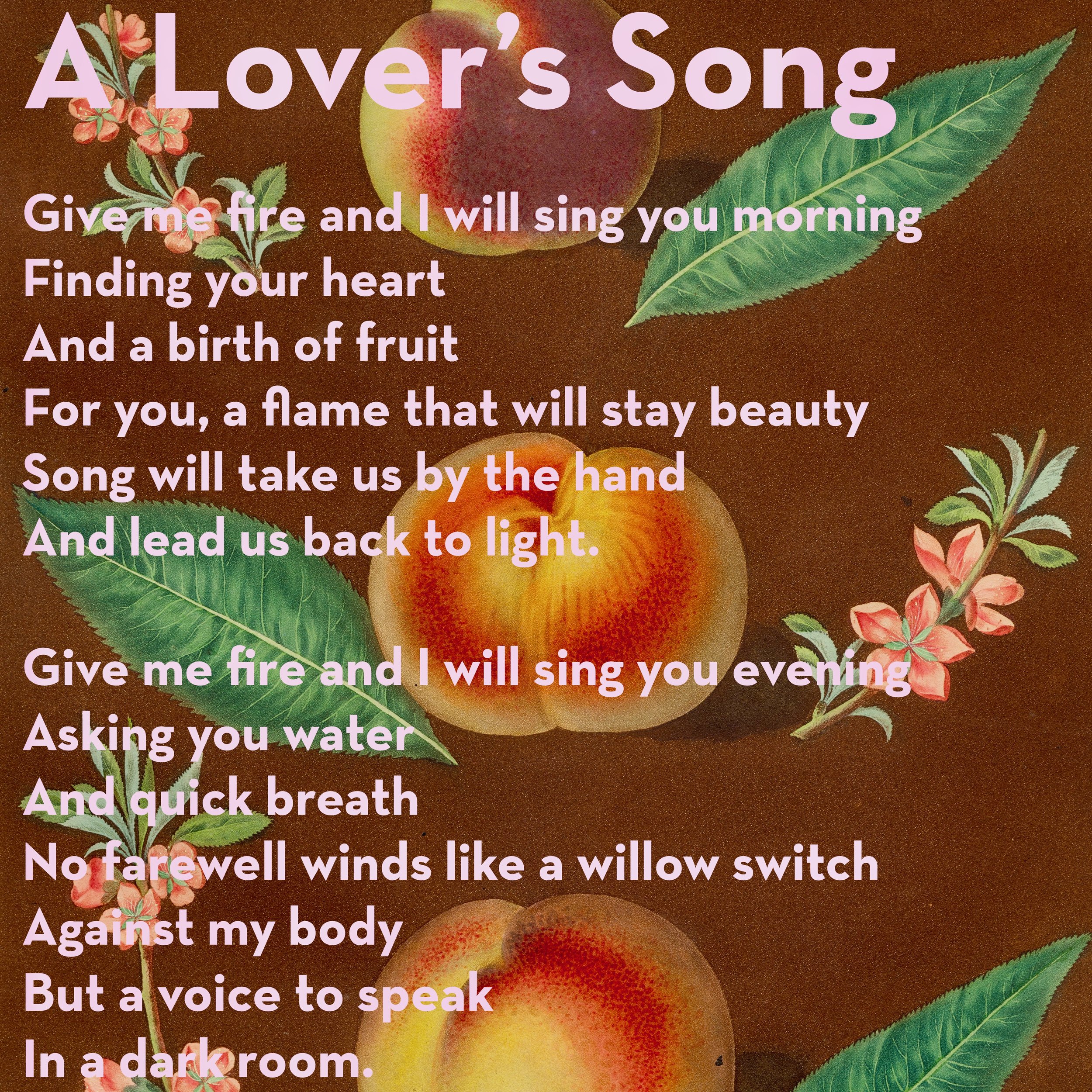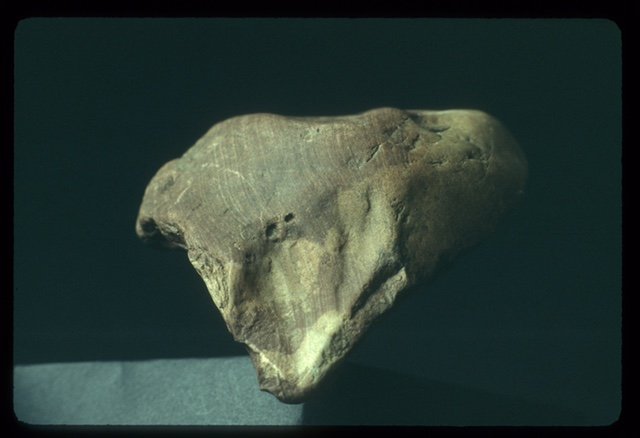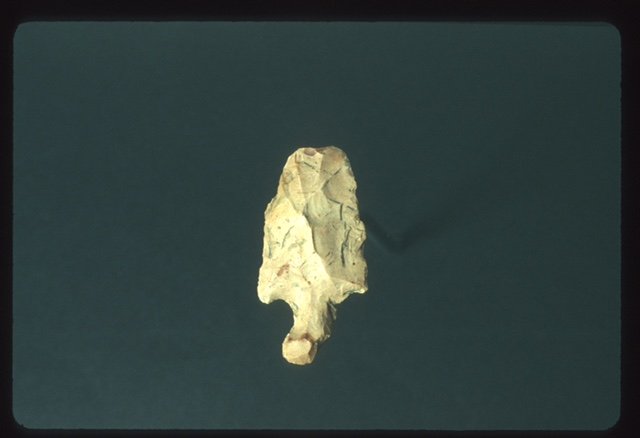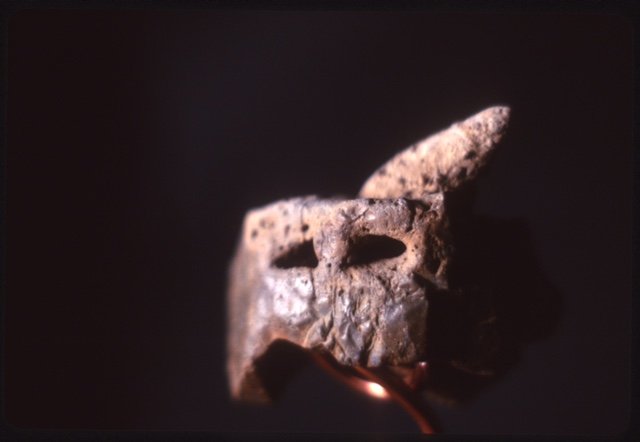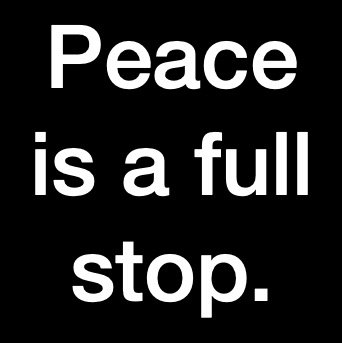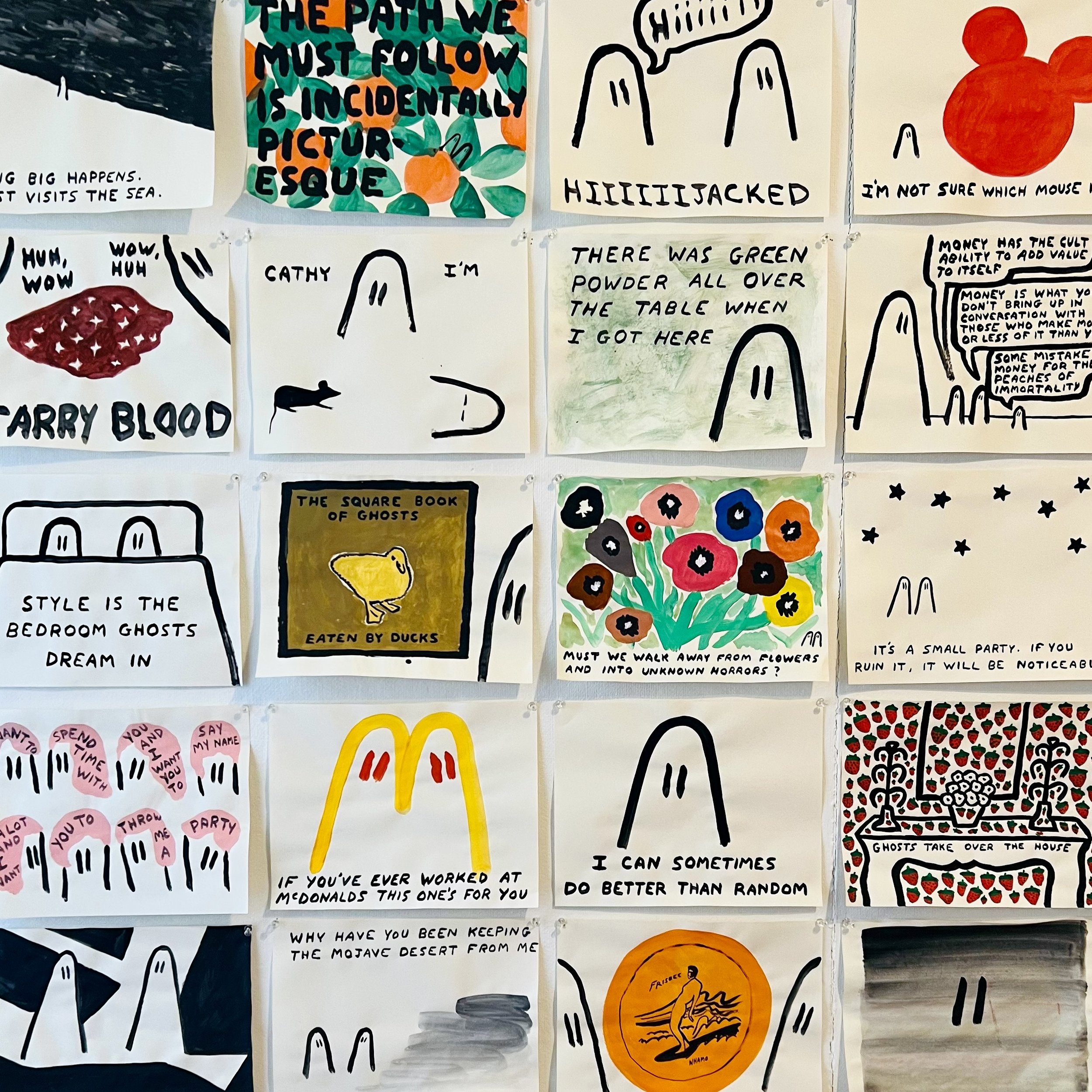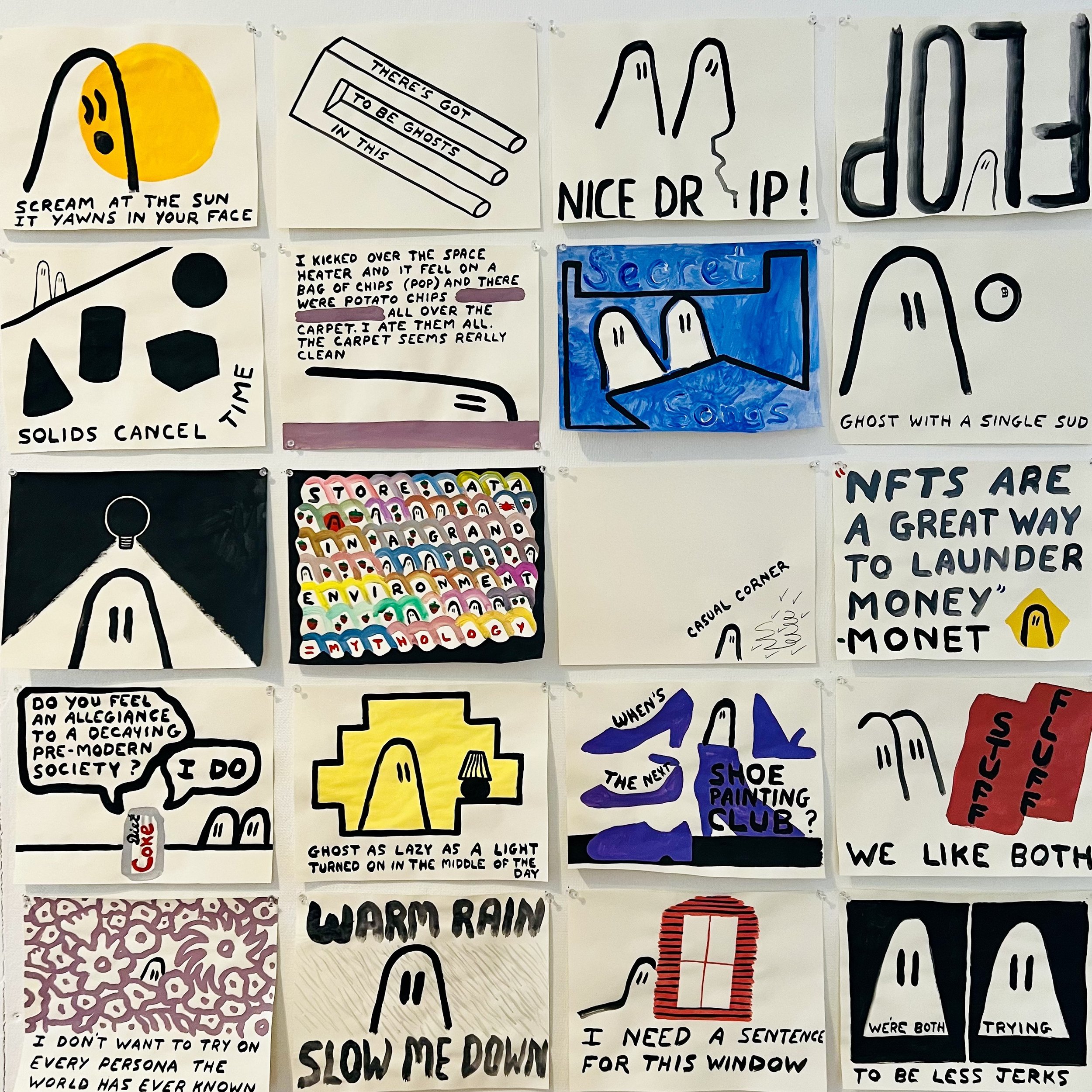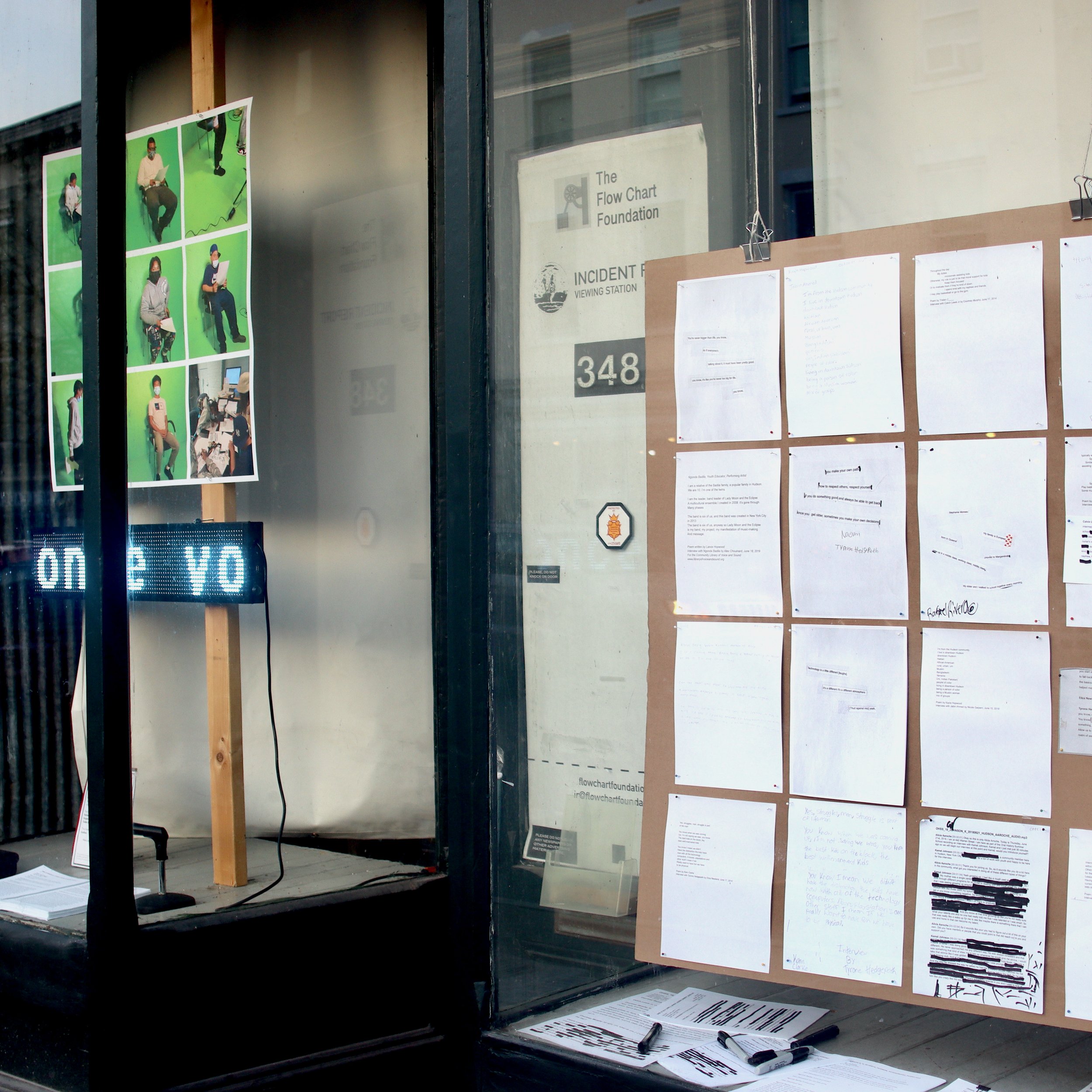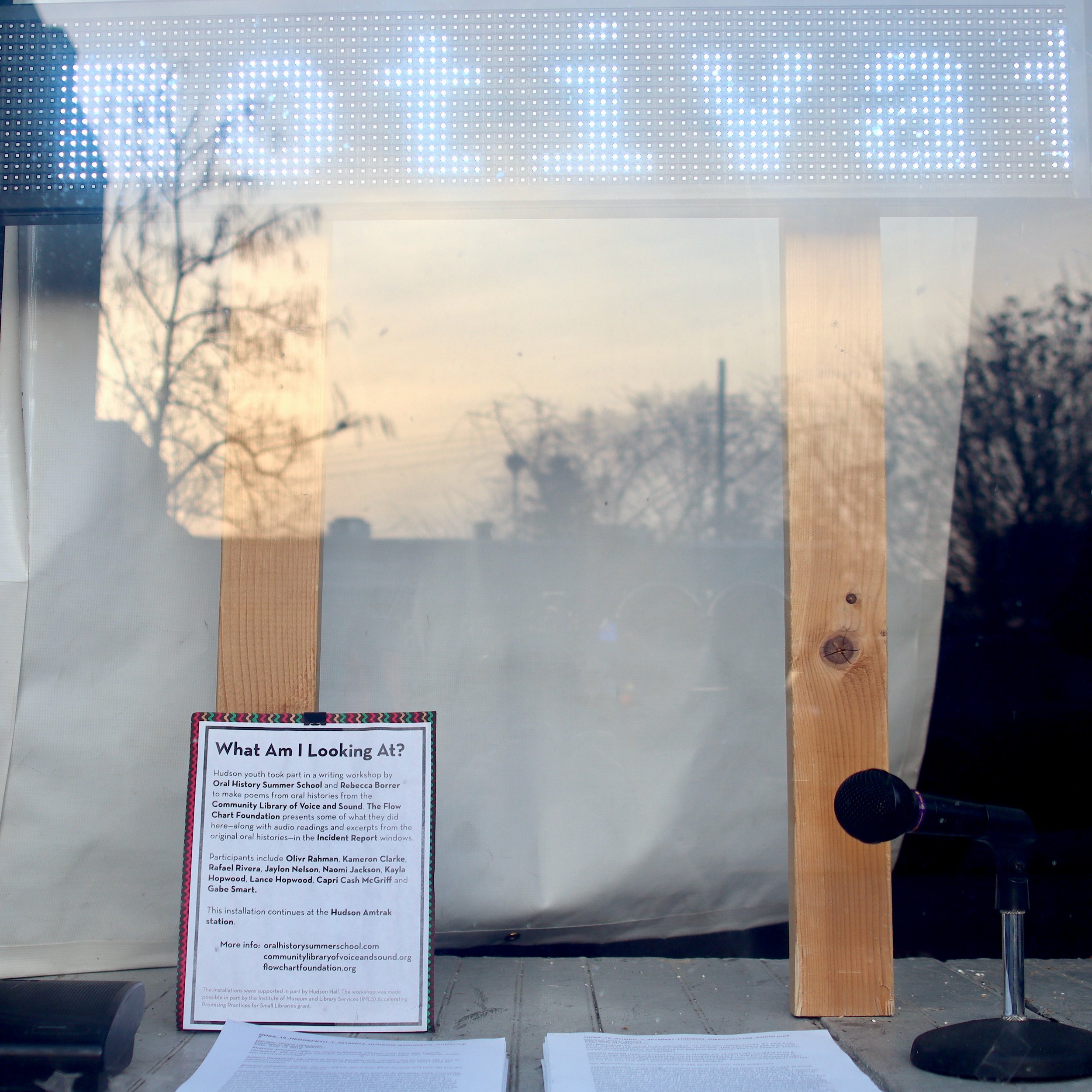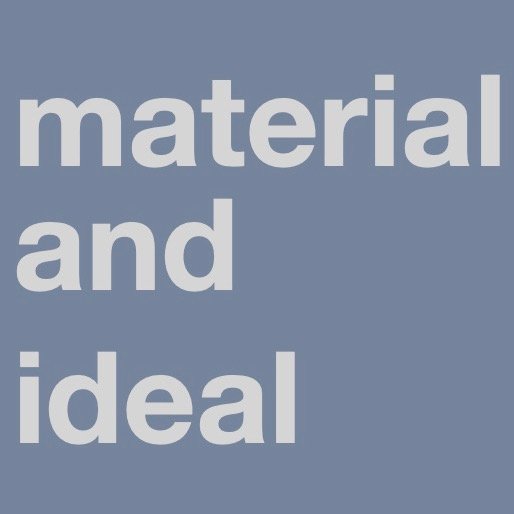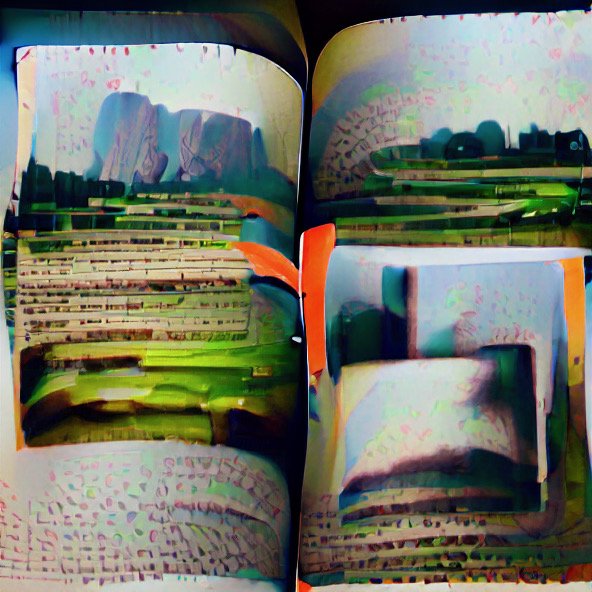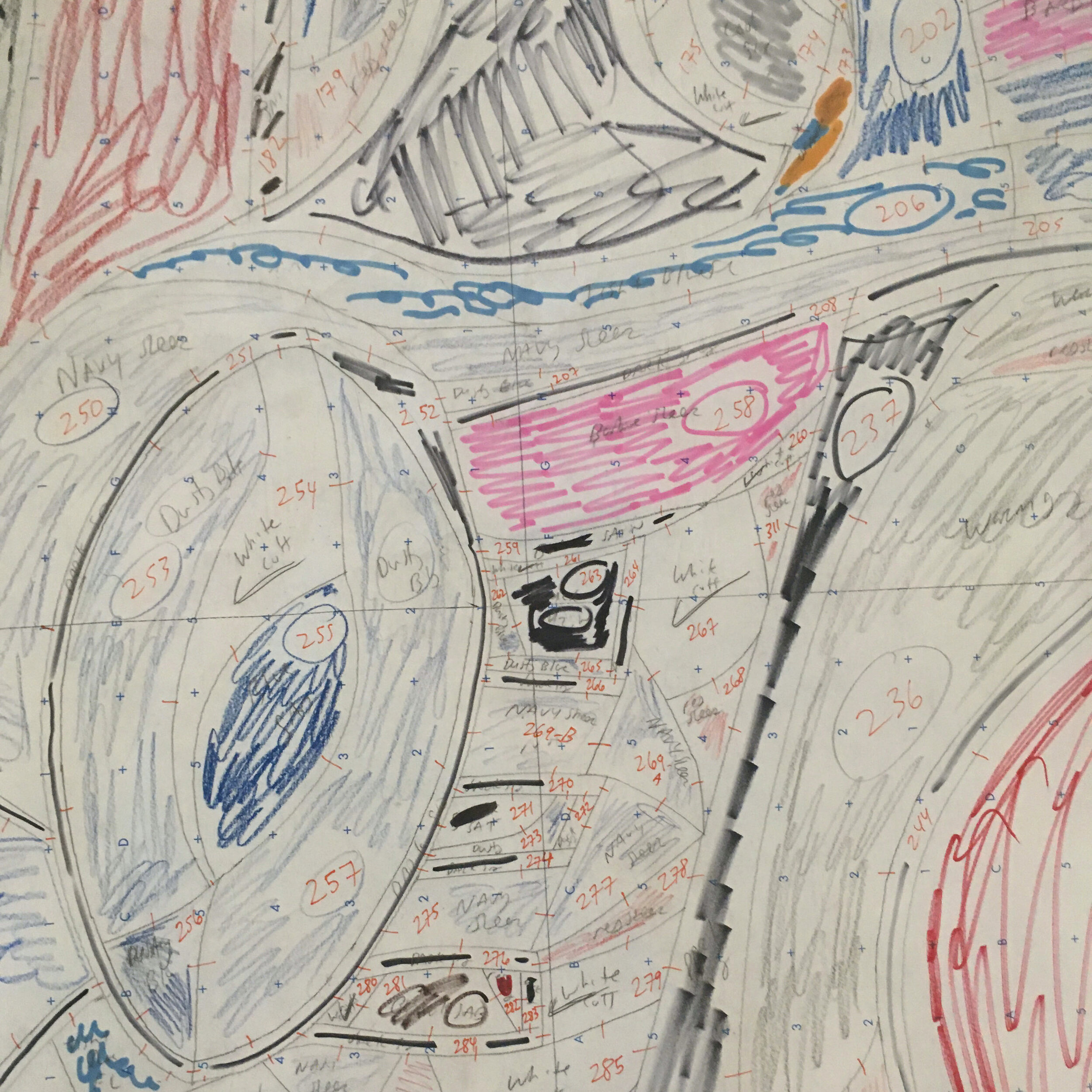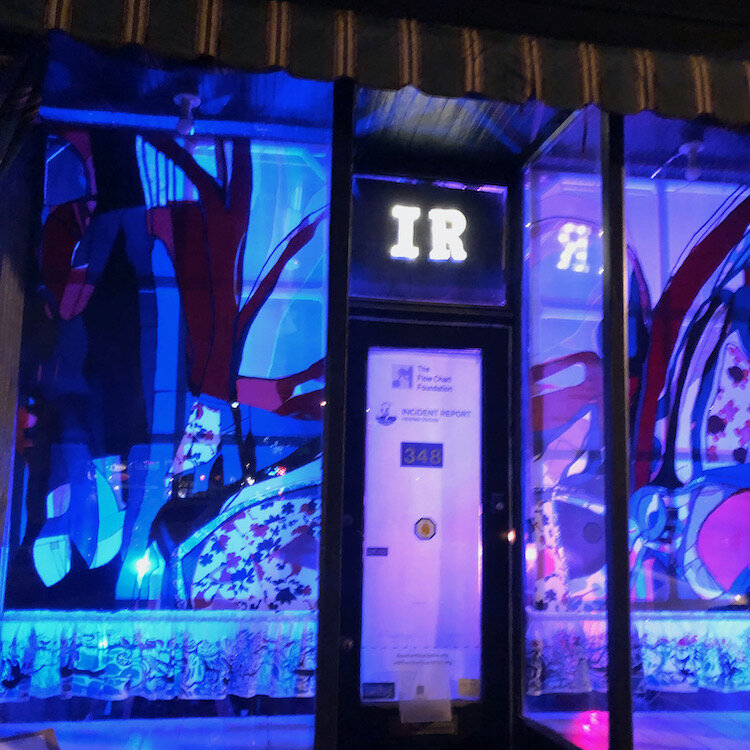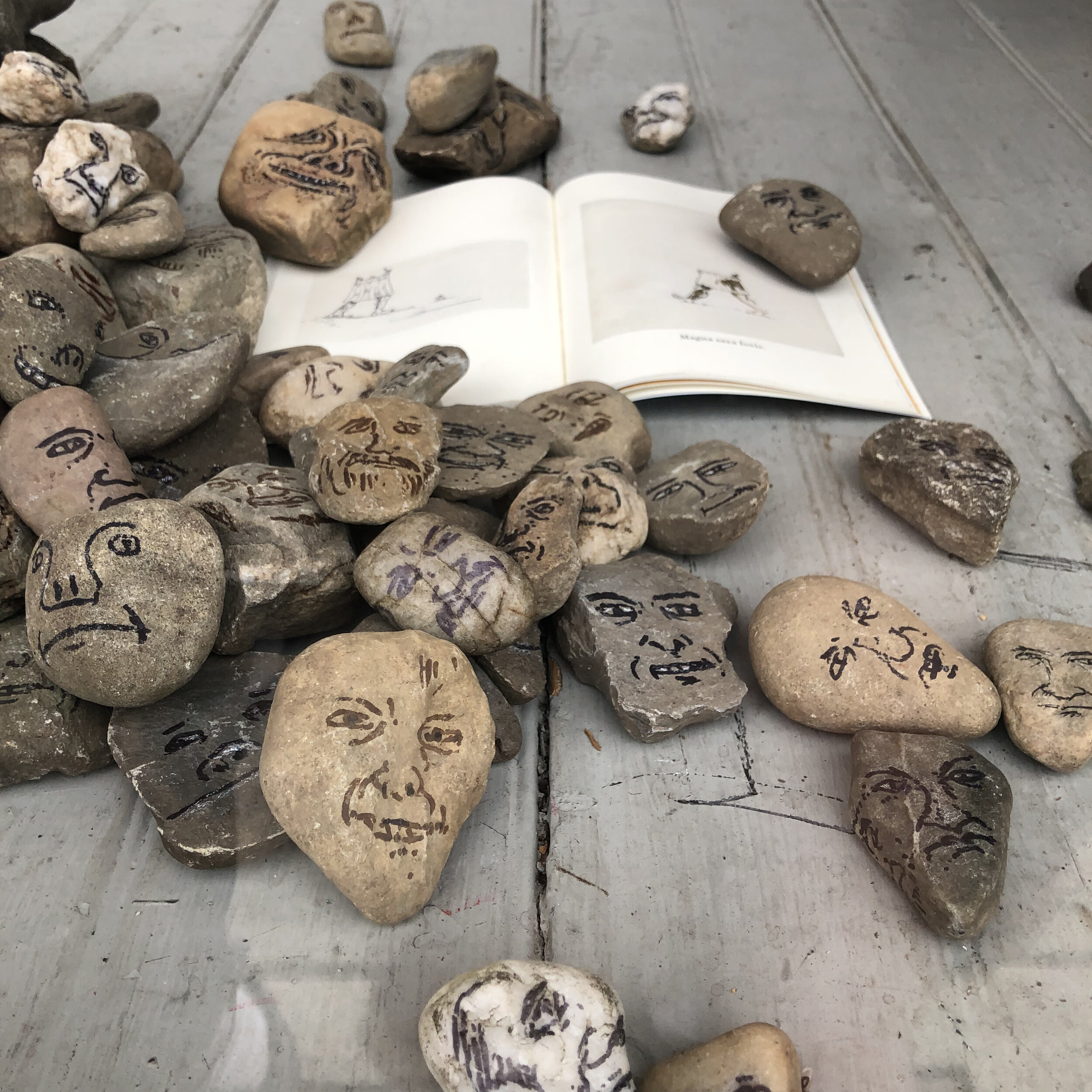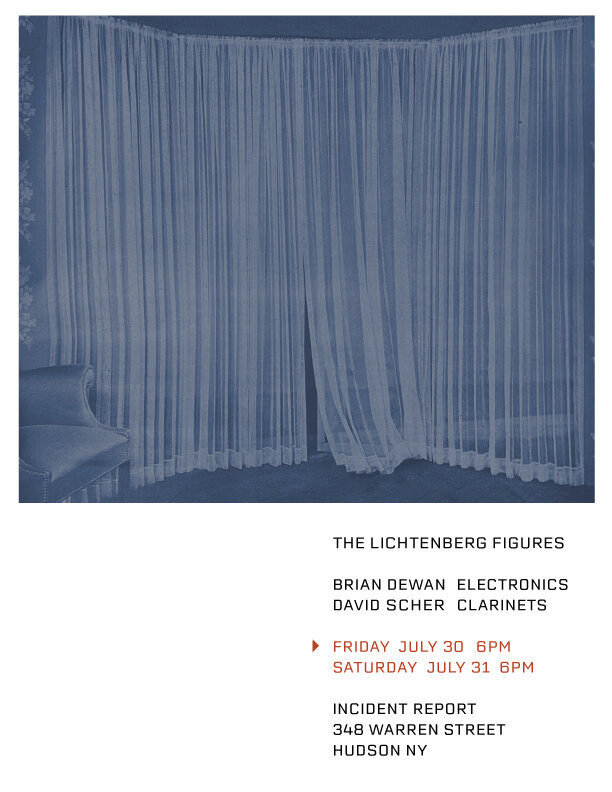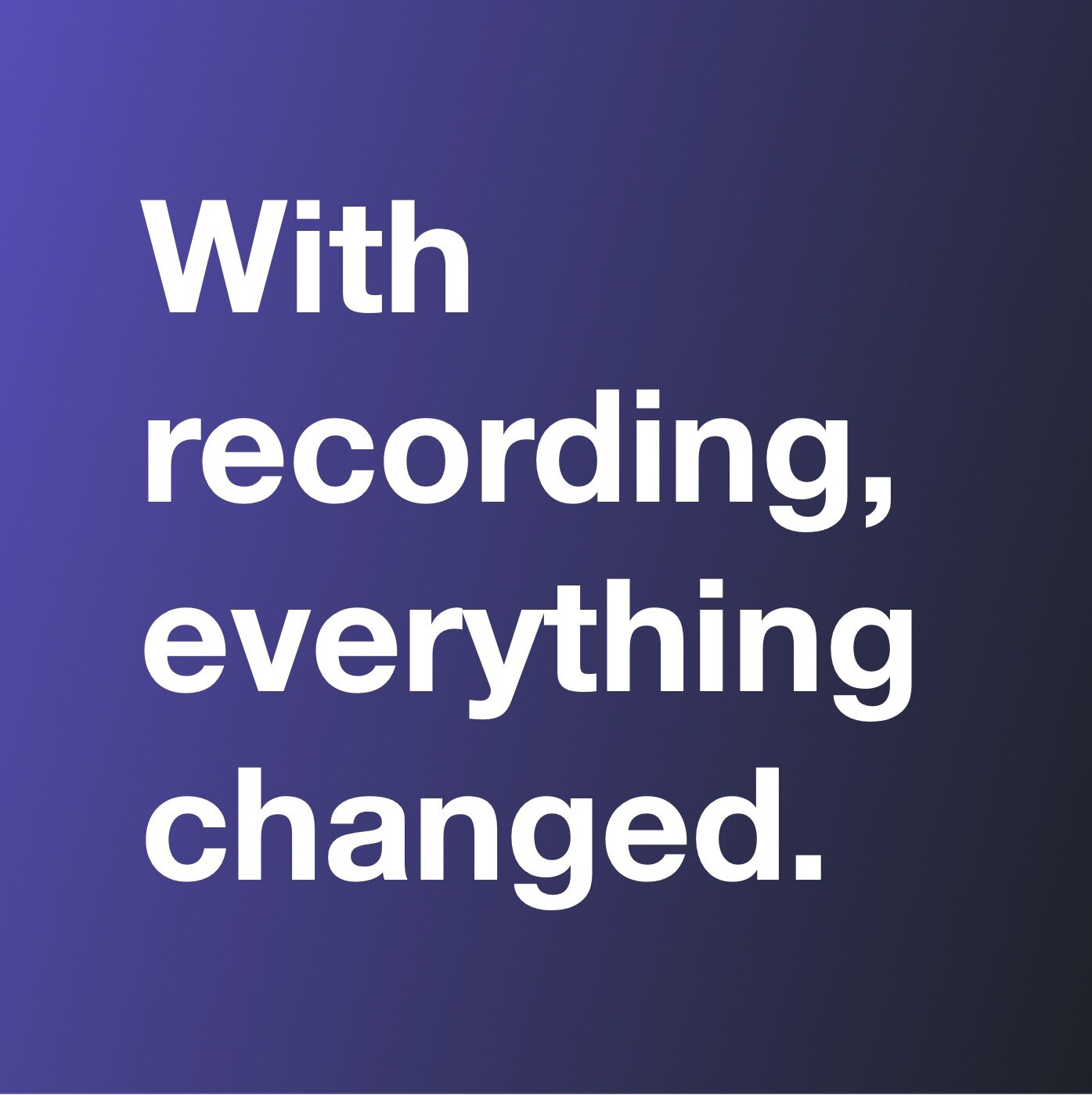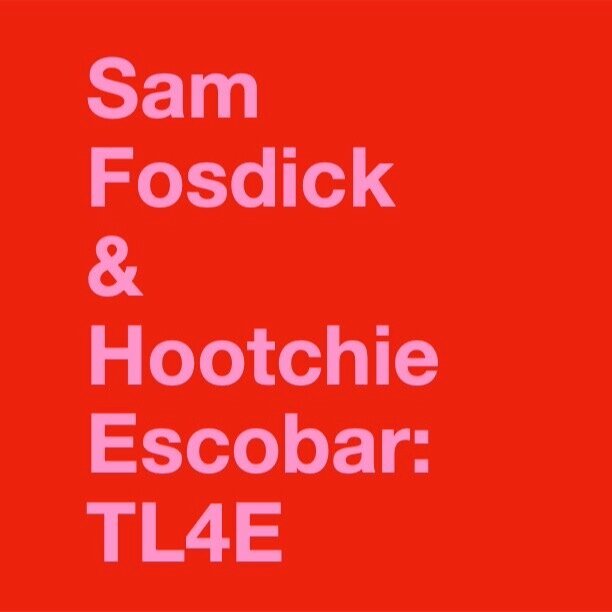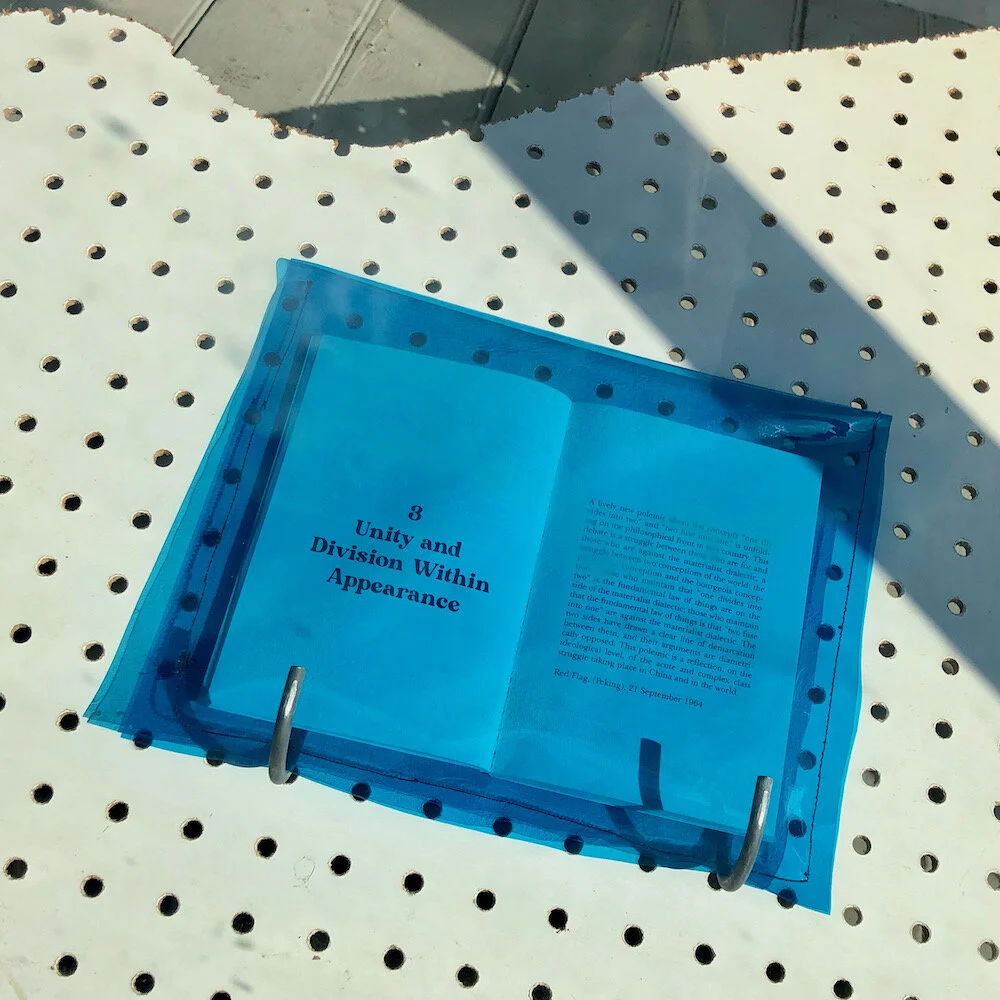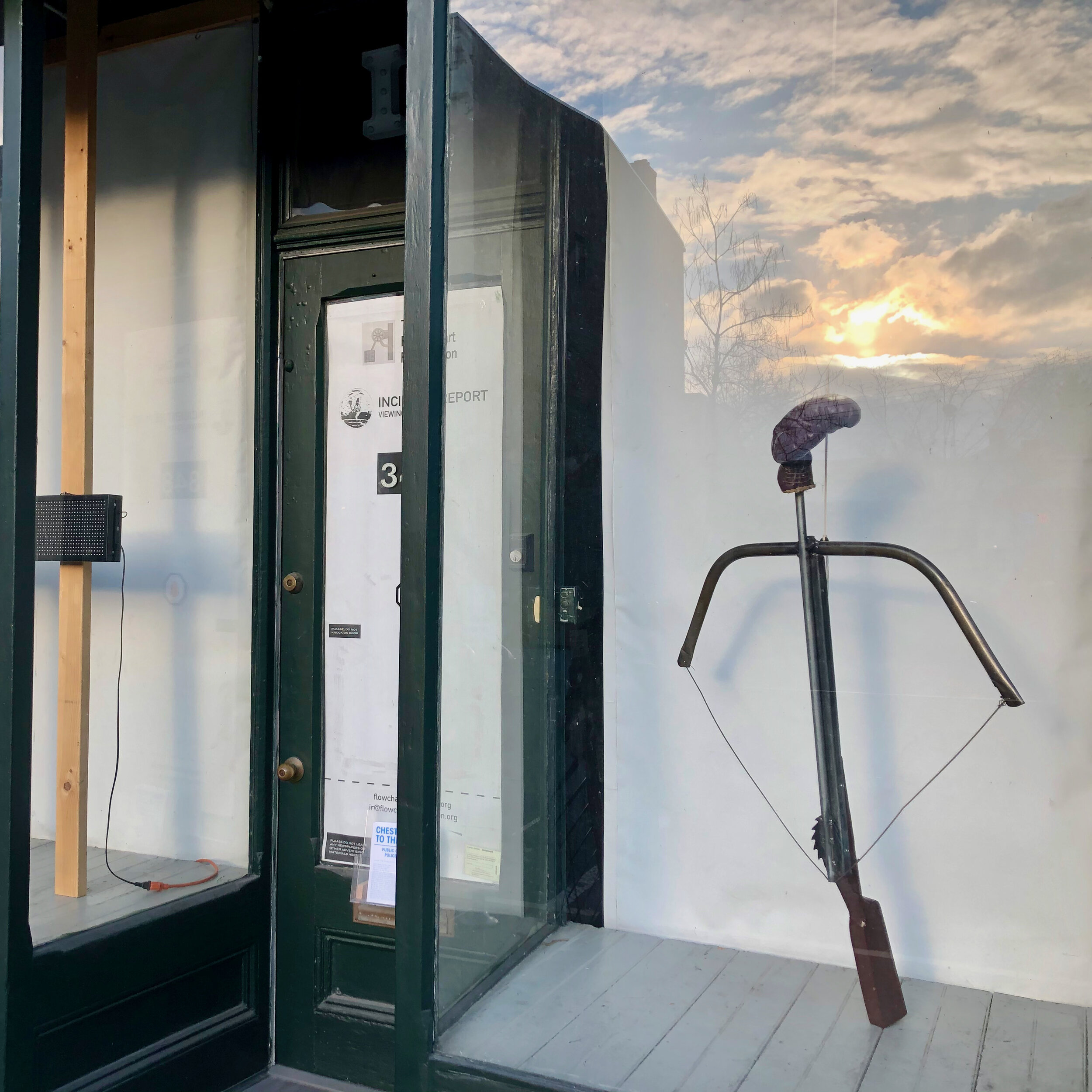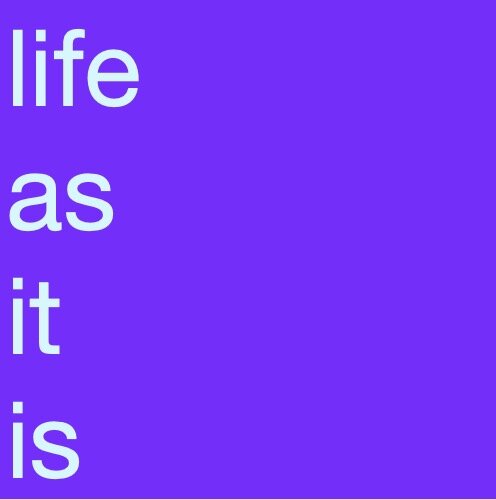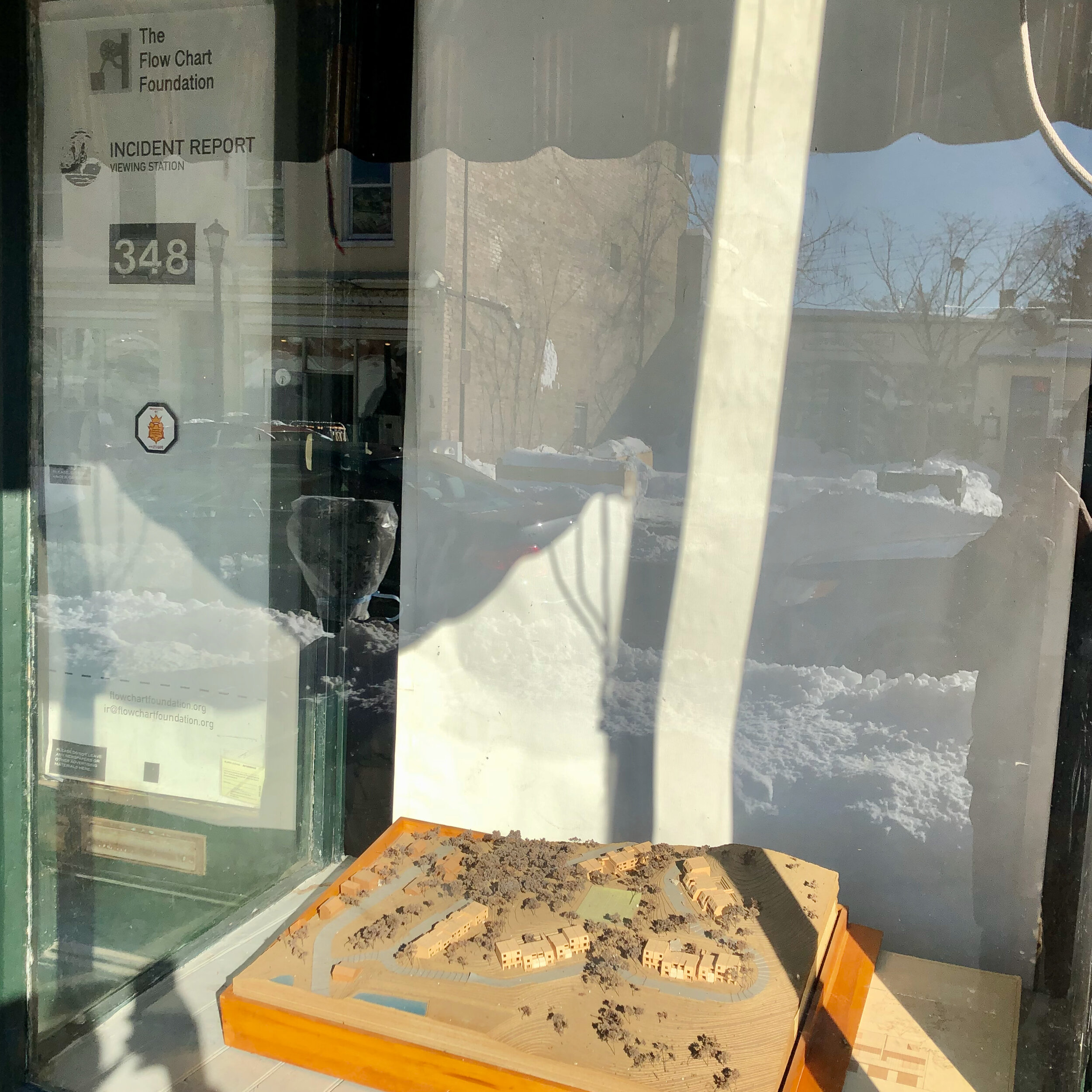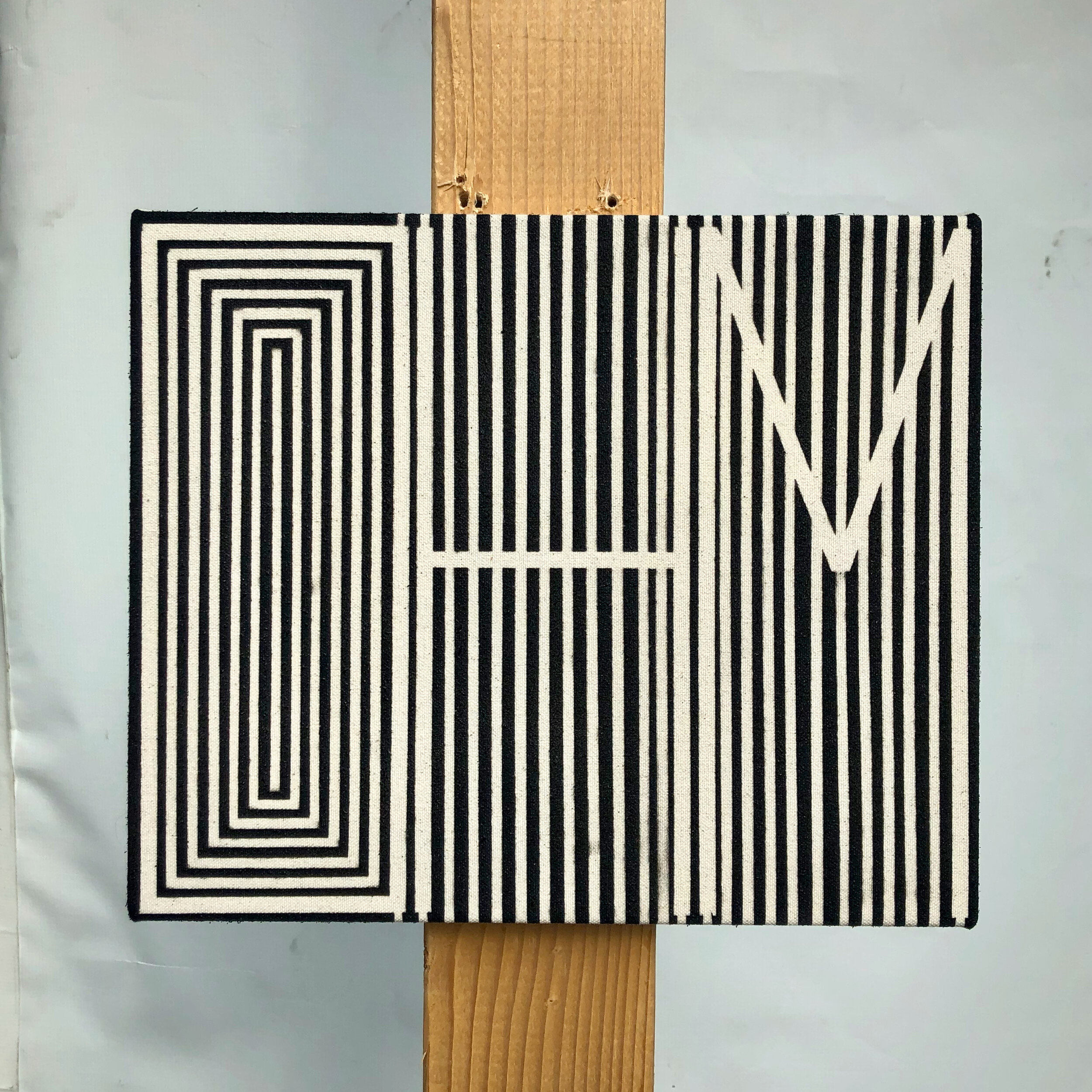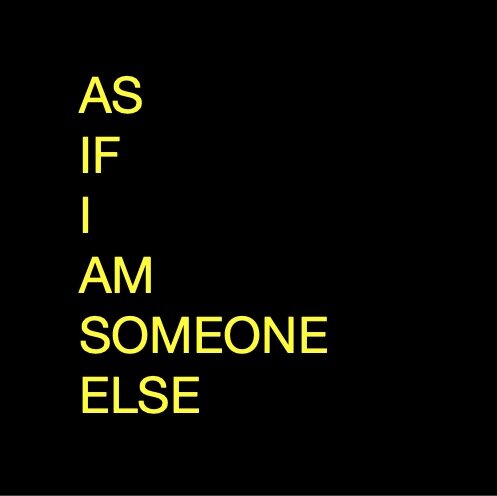Incident Report, the storefront display windows of The Flow Chart Foundation (located at 348 Warren Street, in Hudson, NY), offers an interface with the many publics of the street, showcases concepts and issues generated by artists and social thinkers. Incident Report has featured formally arranged projects as well as improvised situations for more than a decade.
REPORTS
Many of the projects featured in the windows are part of Reports, an experimental publication series displaying poetry, notation, transcription, weather reports, manifestos, public address, inventories, event scores, recipes, news, elegies, missives, codes, prayers, instructions, lyrics and more, often paired with art or object installations, and sometimes video and/or audio..
January – April 2023
Henry’s Dresses
From January throughApril, the Incident Report windows will feature a rotating series of studies using objects from Henry, activated by their literary evocations. Henry is a store run by artist Nancy Shaver. The installation is prompted by a dress covered in buttons and its abstract connection to the poetry of Gertrude Stein and John Ashbery
And a sigh heaves from all the small things on earth,
The books, the papers, the old garters and union-suit buttons
Kept in a white cardboard box somewhere, and all the lower
Versions of cities flattened under the equalizing night.
The summer demands and takes away too much,
But night, the reserved, the reticent, gives more than it takes.
—John Ashbery (from Self-Portrait in a Convex Mirror)
What is the current that makes machinery, that makes it crackle, what is the current that presents a long line and a necessary waist. What is this current.
What is the wind, what is it.
Where is the serene length, it is there and a dark place is not a dark place, only a white and red are black, only a yellow and green are blue, a pink is scarlet, a bow is every color. A line distinguishes it. A line just distinguishes it.
—Gertrude Stein (“A Long Dress” from Tender Buttons)
December 2022
The Master’s Tools
To close the year, the Incident Report windows celebrate Audre Lorde, with one window featuring a scrolling LED text featuring the title of Lorde’s seminal essay, “The Master’s Tools Will Never Dismantle the Master’s House” (and watch a complementary TENTACLE projection of the essay’s final paragraph created for the Hudson, NY’s 2022 Winter Walk celebration), plus a giant typeset version of an early poem (with permission from the Lorde Estate).
October 2022
for a non-accelerating observer
For this art+sound+text installation, artist Les LeVeque tells us that “the objects in this series contain LCD screens of differing resolutions and sizes that are displaying videos from the dIRe Warming Bouquets and dIRe Warming Lily Bouquets series and rolling text videos from the Algorithms for Indeterminacy series.
dIRe Warming (Lily) Bouquets series are durational projects where bouquets of Lilys or Anemones are exposed to varying amounts of near-infrared radiation, that portion of radiation that is just beyond the visible spectrum. The effects of this extended direct infrared exposure, dIRe, are documented with thermal video cameras. The video in these pieces consist of that documentation accelerated.
Algorithms for Indeterminacy is a generative text project. Imagining a relation between two, three or four specific words then submitting those words to an algorithm that generates a combined word list of their synonyms and/or antonyms.”
Les LeVeque is an artist who works with digital and analog electronic technology. His projects include single and multi-channel videos and video/computer based installations. He holds an MFA from Syracuse University with a concentration in Video. He has received numerous awards including: The inVisible art_science International Media Award organized by Südwestrundfunk SWR, Baden-Baden and the ZKM in cooperation with Swiss Television SF DRS and Arte; The Audience Award at Transmediale in Berlin and the Silver Spire award at the San Francisco Film Festival. His work has been exhibited and screened internationally including: The Whitney Biennial, New York; Georges Pompidou Center, Paris; Museum fur Neue Kunst ZKM, Karlsruhe; Australian Centre for the Moving Image, Melbourne; Museo de Arte Moderno, Buenos Aires; Laboratorio Arte Alameda, Mexico City; Centre Culturel et de Cooperation Linguistique Bilbao; Pacific Film Archive, Berkeley; San Francisco Museum of Modern Art; Palm Beach Institute of Contemporary Art; Museum van Hedendaagse Kunst, Antwerpen; The Hammer Museum, Los Angeles; The New Museum of Contemporary Art, New York; Austrian Film Museum, Vienna; Museo Nacional Center de Arte Reina Sofia, Madrid; Anthology Film Archive, New York; REDCAT Roy and Edna Disney/CalArts Theater, Los Angeles; Hong Kong Cultural Art Center; Museu d'Art Contemporani Barcelona; Museum of Contemporary Art, Belgrade; The Nelson-Atkins Museum of Art, Kansas City; The Wexner Center, Columbus; The Russian Museum, St. Petersburg; Image-Movement Cinematheque, Taipei; The Ottawa Art Gallery; Pleasure Dome, Toronto; Kunsthalle Wien, Vienna; Center for Contemporary Art and Culture, Bucharest and The Other Cinema, San Francisco. Festival screenings of his work include: Transmediale, Berlin; San Francisco International Film Festival; Sundance Film Festival, Park City; Viennale International Film Festival, Vienna; Recontres Internationales Paris/Berlin/Madrid; New York Underground Film Festival; Images Festival of Independent Film and Video, Toronto; Clermont-Ferrand Short Film Festival; Leeds International Film Festival; Images du Nouveau Monde, Montreal, ARS Electronica, Linz; Pandemonium Festival of Moving Images, London; International Audio Visual Experimental Festival, Arnhem; Filmothek Oberhausen; Seoul Net Festival and the 2011 New York Film Festival. The Video Data Bank distributes his single channel video work.
August 2022
Found Objects, 2022
Artist Bill Santen tells us of the latest Incident Report installation that: “This series of 35mm photographs documents a collection I have been building over the last 40 years. My longest-held object was found on a Kentucky farm when I was six years old; the most recent acquisition is from the Letchworth State Park canyon in Western New York. The collection includes objects sculpted by humans (tools, arrowheads) and nature (rocks, shells). Living with them over time and assembling them together, I reflect on the attraction and curiosity they inspire, largely due to their mysterious origins: who made them? Who used them? How old are they? To what terrains have they traveled? Is that unique shape and surface the result of human carving or sanding, flowing waves or pounding winds? My father and I mailed the object I found at age six to the University of Kentucky Geology Department, inquiring whether it was an indigenous artifact. Their response was ‘maybe.’ I borrowed this method of “macrophotography” from an American Museum of Natural History exhibition catalogue. While these objects’ handheld size allows me to gather and preserve them, it impedes close looking and attention to detail. At a larger scale, their unique characteristics can be better perceived, and suggest new associations: is it a pebble, or a planet? Alongside the slide show, lyrics to my original song “Gentlemen” appear on the LED text scroll. I hope its descriptions of oxygen, water and passing time will complement the images.” Here’s LED text:
Wishes was out of control, colorblind,sunk here in battle. Rich rising oxygen, gentlemen,I don’t know much, but I’m scared of swimming.I’m scared of stinging and biting flies.
This is as far as I’m going, money is coming and it’s going,but we’re rich, we’re alive, and we’re thinking;we’re still in touch, aren’t we, been through so much,haven’t we, surely this shit catches up. Surely it catches up.
Welcome dear Atlas Thoreau. These dishes will dry on their own.Watering eyes, gentlemen.You don’t know the half of it, can’t wrap your arms around it,can’t climb on board with it, yeah, we’re so bored with it.
Naysaying, not saying nothing (I lied).Not saying up raised or ruin, then you turned 25.Sick sight of oxygen, gentlemen, I don’t know much, but you’re out of touch, out of “doing”, out of doing.
Bill Santen was born in Lexington, KY and currently lives in Buffalo, NY. Between songwriting and the visual arts, he makes portraits of human and natural subjects, hovering between documentary-style narrative and symbolic dream-space. Fragmented stories emerge through research, observation, oral history, memory, reenactment and poetic interpretation. As the songwriter and musician birddog (1995-2005), he released five records, covered in publications including Pitchfork, Mojo and ACE Magazines, among others, and included in films and plays. Since returning to songwriting in 2013, he has played in New York City at venues including Pianos, Pete’s Candy Store, Matchless, the Greene Space and Dixon Place. As a visual artist, he works in 16mm film, video, sculpture and photography. Projects have been screened, performed or exhibited at Sgorbati Projects, Queens Museum, Thomas Erben Gallery, Nicole Klagsbrun Gallery and the Bronx River Art Center (all NYC), Raft of Sanity and Play/Ground (Buffalo); and abroad at the Masc Foundation, Vienna, Austria; Wschodnia Gallery, Lodz Poland; and the Overgaden Museum of Contemporary Art, Copenhagen, Denmark. He has been an artist-in-residence at Mildred’s Lane in Narrowsburg, Pennsylvania; and earned his MFA from Columbia University and his BA from the University of Kentucky, College of Fine Arts. He dreams of someday seeing a bear in the wild.
July 2022
Gathering: The Tennis Court Oath at 60 / John Ashbery at 95
On the occasion of The Flow Chart Foundation’s first Gathering, we feature the title poem of The Tennis Court Oath (1962), scrolling on the LED, along with audio of Ashbery reciting the poem (from a recording taken at Washington Square Gallery in 1964). In the second window, a single line from the poem “Chinese Whispers” from the 2002 book of the same title.
June 2022
Deep Fakes
This text + paintings installation is by artist Kyla Kegler. She tells us that “the paintings are from the series Deep Fake. The title references the notion of "fake depth" named after the term Deepfakes (a portmanteau of "deep learning" and "fake") which refers to synthetic media in which a person in an existing image or video is replaced with someone else's likeness. The paintings are composed of solid ultra-matte opaque fields of color, designed after principles of color theory to describe the illusion of overlap and depth on a flat surface.
The process of making these paintings is methodical and formulaic, mixing each hue to just the right value so that all shapes in the composition move forward and backwards rhythmically. Like scratching away the silver wax on a lottery ticket to see the worth of what emerges, I never know if a painting works until the last color is filled in. Then I make adjustments until it sings. Singing means they vibrate between multiple forms / relationships / planes endlessly and non-hierarchically. They at once give the viewer something to chase/navigate and somewhere to rest.
A peacock’s feather, an abalone shell, a soap bubble— these surfaces demonstrate the relative-to-light illusion that is color. When a form is unstable, embedded in the experience of seeing it is the sense of chasing it. In these paintings I’m searching for a vibration that offers both rest and revelation.”
Here’s the text scrolling on the LED display:
overlapped lemon and ultramarine plus white and hot pink, overlapped lemon and navy plus white and hot pink, overlapped black and hot pink plus white and yellow
Kyla Kegler is an artist born and based in Buffalo, NY. She makes paintings and performances that highlight slippage, pleasure, and the awkwardness of being human. Her practice has been shaped by working with Bread and Puppet (2006) and living in Berlin (2008-2016). There she was a co-founder of Zuhause — an underground theater (2011-2013); was one of the founding teachers at yellow yoga, a ‘Community Supported Yoga Project’ (2012-2016) and was active in Berlin’s contemporary dance scene, receiving her MA Solo/Dance/Authorship at the Art University of Berlin 2015. Since returning to Buffalo, Kegler has been an MFA Fellowship holder in Studio Art at the University at Buffalo 2018, received numerous NYSCA grants for socially-engaged projects, and consistently shown across North America and Europe. In October 2021, Kegler founded curatorial project Agatha's— two micro galleries inside confessionals at her studio, located in a former catholic school chapel in South Buffalo. You can find more of her work on instagram @kyla.kegler.
May 2022
Existential Cartoons
Julia Dzwonkoski provides a selection of recent drawings “pulled from the comedy and poetry of everyday life and language.” She “keeps them loose and lets a lot in.”
Julia Dzwonkoski is an artist based in Buffalo, NY. You can find more of her drawings on instagram: @juliadzwonkoski
April 2022
Cobweb Spells
This text and object installation—inspired by cobwebs, apotropaic spells, time capsules, and trinket boxes—comes to us by way of Hudson-based artist, weaver, educator Margot Becker. She tells us that “the vessels are filled with found, foraged, and gifted materials. They are the result of compulsive collecting, and superstitious saving placed in relationship with careful intention. I attend to preciousness, pocketed desires, and mending, while emulating the tiny, tangled enmeshments of house spiders. With wonder and grief, I consider species loss in an epic network of interconnection over time and space. With my hands, I seal the ingredients of these charms together with beeswax and hold them in place with hand-spun yarn.”
Here’s the LED text:
beeswax glass crystal eucalyptus buds horsehair sharks tooth plastic pearl allium petal cut glass lady beetles bumble bee sunflower husk cottonwood buds rose petal daffodil marble herkimer diamond rose hips mohair strawflower porcelain kitten piñon wild iris doe teeth amethyst lavender angora mouse ribs skull glass beads sparrow blood juniper berries yarrow stalks fresh water pearl glass crystal wool ammonite marigold rabbit bone dust
Margot Becker is an artist, weaver, and educator based in Hudson, NY. Her work explores sense of place, the natural environment, and the connection between the individual and the communal subconscious. Through tactile processes, she questions our understanding of sustainability, the value of labor and the role of handcraft in late capitalism. Her weaving practice originated from a desire to understand the origins of cloth and the lives affected by it. In 2010, Margot embarked on a study to understand the process of creating textiles from start to finish. Following the belief that to know your production line, you must be your production line, this project became an all-encompassing life practice- incorporating animal husbandry, yarn spinning technologies and fine hand weaving. Her work has been exhibited in New York, San Francisco, and Los Angeles. She received her BA from Bard College in 2009 and her MFA from California College of the Arts in 2020.
January 2022
Dispatch
Candice Hopkins and Raven Chacon fill the Incident Report windows for the end of January into February, The installation features a “multi-part text score called “Dispatch,” scrolling on the LED and a sound piece by Chacon called “Pinefire Song,” from his album Anthology of Chants Operations, playing out onto the street. Hopkins’ and Chacon’s offerings are complemented by objects placed in the windows as well. Candice Hopkins and Raven Chacon: Dispatch is published as part of Unsettling Scores, for which it was originally conceived. The “Unsettling Scores” series is curated by Liquid Architecture for Monash University Museum of Art in conjunction with the exhibition Samson Young: Real Music. Bringing together artists, musicians and writers from around the world, the series examines how experimental and political sound and acts of listening — grounded in the language of musical scores — become vehicles of unsettlement, disrupting logics of settlerism, extractivism, expropriation, and appropriation, while at the same time offering powerful assertions of sovereignty, resistance, and futurity.
Here’s an excerpt from the scrolling text:
DISPATCH #1: The Call
This rock is under threat.
We need to gather here to protect it.
Our actions begin and end at this place.
PLAYERS:
Hosts – People who live and have lived here for centuries.
Spiritual leaders – Indigenous people from any tribe or nation.
Front line activists – (Native and non) ready and willing to engage directly with police, militia, or construction crews.
Militant Indigenous people – Group of their own. Willing to engage in direct action. Not necessarily in collaboration with front line activists or the hosts.
Narcs – (Native and non) undercover police. Any one participant can be a narc.
Reporters – Chronicle for those outside the grounds (as well as inside the grounds).
Politicians – Bring attention. Appear to be listeners. Also there for face time.
Counter-surveillers – To surveille the police and encroachers.
Helpers – (Native and non) brings supplies, food, or a necessary skill. Stays out of the way. Take minimal space and resources.
Witnesses – Listen and observe.
Artists – Engage in creativity, but also self-agenda/promotion. Has the potential to aid the camp in forming its identity. Their artwork can use up resources (water, heat, electricity).
Gatekeepers – Maintain the entrance to the camp. Vet those who enter. A host or trusted by the hosts.
Temporary campers/sympathizers – Bring attention to the cause, temporarily. Cannot or do not know how to belong to the camp.
Others – Tourists, those without a home, others
At a minimum, participants should join with the intent of taking the role of a witness or helper.
DISPATCH #2: The Gathering
Rocks have harmonics, resonant frequencies. They are also deities, lives begun millions of years ago, witnesses to the formation of the earth. They can pick up the tremors of extractive colonialism exposing wide caverns that lead to trails deep inside the ground, generating sludge and slurry, releasing poisons meant to stay undisturbed. The time is now to protect these rocks as though it is a last stand. Our gathering can open up the way to other worlds, those of our own making. These other worlds are not de-colonial ones, but non-colonial ones. Not bound by their frameworks, but by ours. Heeding this call is the first action. In this action we come together, in-person or at a distance, to open up a portal of shared experiences.
Choose one or more prompts to follow (consider the prompts as protocols—of relation, of listening, of action, of witnessing, of performing) :
Heed the call
Hosts determine points of reference
If you are not already there, arrive
Gatekeepers welcome and relay protocols of place
Do nothing (activated at any time)
Listen (ongoing)
Listen beyond (to your immediate surroundings, to the land or water, to sounds outside your normal range)
Sustain yourself (don’t be in the way, don’t encroach); at the same time, be useful (observe; introduce yourself, unobtrusively; deliver supplies; find your place; determine your role, humbly)
Broadcast outward (for any player at any time). Also determine what is not to be shared
Create a small gathering (5 people or less) for one activity. Do something—cook; pray; sing; teach a game
If necessary, initiate a larger gathering
Witness, relay what you learned
Translate a broadcast for other listeners—consider different languages, different tones
This score can be realized as a performance or as a series of imagined events. It can also be enacted in the real world. The players, the prompts, and the schematics are derived from an analysis of the dynamics and organization of the Water Protectors in defense of Standing Rock during the noDAPL movement, not glossing over the miscommunication, profiteering, and injustices. In an increasingly fractured society, new paths and new formations are needed to refocus our attention in an attempt to find truth. Participating in this score may produce sonic or visual artifacts, these are as important as the actions.
Candice Hopkins is a curator and writer of Tlingit descent originally from Whitehorse, Yukon. She is Senior Curator of the Toronto Biennial of Art and co-curator of the 2018 SITE Santa Fe biennial, Casa Tomada. She was a part of the curatorial team for documenta 14 in Athens, Greece and Kassel, Germany and a co-curator of the major exhibitions Sakahàn: International Indigenous Art, Close Encounters: The Next 500 Years, and the 2014 SITElines biennial, Unsettled Landscapes in Santa Fe, New Mexico. Her writing is published widely and her recent essays and presentations include “Outlawed Social Life” for South as a State of Mind and Sounding the Margins: A Choir of Minor Voices at Small Projects, Tromsø, Norway. She has lectures internationally including at the Witte de With, Tate Modern, Dak’Art Biennale, Artists Space, Tate Britain and the University of British Columbia. She is the recipient of numerous awards including the Hnatyshyn Foundation Award for Curatorial Excellence in Contemporary Art and the 2016 the Prix pour un essai critique sur l’art contemporain by the Foundation Prince Pierre de Monaco. She is a citizen of Carcross/Tagish First Nation.
Raven Chacon is a composer, performer and installation artist from Fort Defiance, Navajo Nation. As a solo artist, collaborator, or with Postcommodity, Chacon has exhibited or performed at Whitney Biennial, documenta 14, REDCAT, Musée d’art Contemporain de Montréal, San Francisco Electronic Music Festival, Chaco Canyon, Ende Tymes Festival, 18th Biennale of Sydney, and The Kennedy Center. Every year, he teaches 20 students to write string quartets for the Native American Composer Apprenticeship Project (NACAP). He is the recipient of the United States Artists fellowship in Music, The Creative Capital award in Visual Arts, The Native Arts and Cultures Foundation artist fellowship, and the American Academy’s Berlin Prize for Music Composition.
Community Has Its Limits
Artist Becky Brown provides the latest Incident Report text+art installation. Here’s what she has to say about it:
This collection documents contemporary overuse of the word “community,” reflecting on meaning in the face of repetition. Found phrases form an inventory of communities large and small, open and closed, specialized and generalized, political, professional, regional and cultural. How do we define “community,” and how, why and to what end can a word be exploited by American society at a particular moment in time? For my Incident Report, I pair this ongoing text collection (last modified December 29, 2021) with a six-foot-high, mixed media 35mm slide sheet. Incorporating a variation of the same collection, this work on paper matches real and invented uses of the word “community” with layered pictorial compositions. It is part of my ongoing series reconfiguring found images and text into oversized calendars, notebooks, maps and other physical tools increasingly replaced by digital substitutes. By adapting the slide sheet, I reflect on images that circulate digitally, from family photos to artwork – often making such image categories interchangeable. While this certainly increases our access to images, and the quantity of images we’re exposed to, what does it do the quality of our exposure?
Here’s an excerpt from the scrolling LED text:
The intelligence community
Community Has Its Limits, 2018, Acrylic paint, pencil and collage on paper, 65 x 55 inches
The mindfulness community
The solutions-based community
The plant community
The recovery community
The alternative investment community
The sleep community
An exceptional community
The far-right internet community
The special operations community
The wider community
The life-extension community
The microbial community
The truth-based community
The emergency management community
The male community
The visual thinking community
The cave-diving community
The immediate community
The rock community
The Americana book-collecting community
Becky Brown was born in Manhattan and currently lives in Buffalo, NY. She works between painting, drawing, sculpture and installation using found images, objects and texts. Everything begins with material that already exists, such as newspaper clippings, overheard phrases or discarded appliances. She questions whether unlimited access to information and communication actually brings us deeper knowledge or human connection. She received her MFA from Hunter College and teaches at SUNY University at Buffalo. Solo and two-person exhibitions include Arts+Leisure Gallery (NYC), PS122 Gallery (NYC), the Handwerker Gallery (Ithaca, NY) and Fort Gondo Complex for the Arts (St. Louis, MO). Group exhibitions include The Drawing Center, Queens Museum, Freight+Volume Gallery and A.I.R. Gallery (all NYC), the Buffalo Institute of Contemporary Art (Buffalo, NY) and Religare Arts Initiative (Delhi, India). Her installation “No, said the Fruit Bowl,” in the kitchen of an abandoned home on Governors Island, was described in The New York Times as “machines vomiting as if in a bulimic’s nightmare.” She has been an artist-in-residence at MacDowell, Yaddo, Jentel, and the Edward Albee and Saltonstall Foundations, among others. Her writing has been published in Art in America and The Brooklyn Rail.
December 2021
Blackout Poems: Hudson Youth and the Community Library of Voice and Sound
This Incident Report windows installation feature images, LED text and sound is part of a three-part installation traversing Hudson, NY.
Hudson youth took part in a writing workshop by Oral History Summer School and Rebecca Borrer to make poems from oral histories from the Community Library of Voice and Sound. Participants include Olivr Rahman, Kameron Clarke, Rafael Rivera, Jaylon Nelson, Naomi Jackson, Kayla Hopwood, Lance Hopwood, Capri Cash McGriff and Gabe Smart.
The installation consists of a set of Amtrak Poetry placards, up through January 15th; a one-night Tentacle projection from the Hudson Hall opera house as part of the 25th anniversary of Hudson’s Winter Walk; and a multi-media Incident Report installation including scrolling LED text of provocations from Hudson oral histories, images, objects, and audio of the participating youth reading their poems + bits of the original oral histories.
The Community Library of Voice and Sound aims to preserve the widest possible range of experiences in the Hudson area, to document the communities’ complex history in the words and voices of its participants. The archive is comprised of oral histories conducted by Oral History Summer School students in conversation with residents from Hudson and the surrounding communities, with an emphasis on “everyday life” experiences, past and present. So far, the collection gives voice to themes including: architecture, industrial history, farming, gentrification, racism, civic spaces and institutions (the prison, library, and schools), churches, social clubs, preservation, use of space and small businesses. With this archive, we hope to promote and encourage dialogue, in the collaborative process of interviewing and in the process of sharing the interviews with listeners. We view interviews as opportunities for residents to reflect on their lives/experiences and as opportunities to envision individual and community futures.
The workshop was made possible in part by the Institute of Museum and Library Services (IMLS) Accelerating Promising Practices for Small Libraries grant. The installations were supported in part by Hudson Hall. Photos of the Incident Report windows by Rebecca Borrer.
November 2021
on indeterminacy and on
This latest contribution to the Reports scrolling LED project features a text by Joe Milutis. Here’s an excerpt:
Indeterminacy is not not-being nor not not you.
Indeterminacy’s a good host—
indeterminacy includes you (but you, guarded, rarely include it.)
Indeterminacy is not not meaning but is not meaning if by meaning we mean only that
which is filtered through the sense of language.
Indeterminacy—the only way language becomes photography.
Indeterminacy is the actual being-with-in a work. The being-with-you.
Indeterminacy is image and not image
in that one image only becomes such by activation of another.
There is no pure “image” and yet, it exists and this is the indeterminate.
Indeterminacy, as Bergson suggested, is at the core (or the corps) of being yet is between
material and ideal.
Indeterminacy, not fully there, still forms the core (or corps) of presence.
Also, indeterminacy is incorporeal.
Is indeterminacy inadequate?
This is not indeterminacy, because it is already written.
So the challenge would be to
determine what is indeterminate about this.
Finding this indeterminacy, would that make this more worthwhile, or less.
And in this case is less more?
Is indeterminacy all that is the case.
What is indeterminate about the wood chair in the wood room?
Indeterminacy is the would.
When the picture on the wall reassembles in half-dreams, indeterminacy.
Indeterminacy is coterminous with the all in small.
In indeterminacy is redundant.
You are always “in” indeterminacy.
Yet, not in determinacy.
If you are still you, which means not still you.
Indeterminacy—when a transcription becomes a new thing, born again.
Indeterminacy—when the copy
is Xeroxed out of existence.
Does indeterminacy erase itself?
The body is a bad approximation of indeterminacy, although indeterminacy is about
bad approximations.
Indeterminacy is when the word doesn’t work.
There is nothing in body you don’t already know, which is why indeterminacy is the wrong word for this.
Indeterminacy is in the cool, cool, cool of the evening.
Joe Milutis is a writer, media artist and Associate Professor of Interdisciplinary Arts and the MFA in Creative Writing and Poetics at the University of Washington-Bothell. Work has appeared in Fence, Triple Canopy, Cabinet, PennSound Authors, Jacket2, Tagvverk, Gauss PDF, as well as a variety of performance and gallery venues. He is the author of Failure, A Writer's Life (Zer0 Books: 2013) and Ether: The Nothing That Connects Everything (University of Minnesota Press: 2006). He has recently completed an experimental translation of Michael Maier’s alchemical poetry in Atalanta Fugiens, and is working on a long poem related to the history of Italian painting.
October 2021
The Red, See
This two-window installation showcases artist Will McLeod’s unique and angsty textile storytelling. The upper diptych that dominates the Incident Report windows is a sparring dance between red and blue where both everything and nothing happens of any legible significance. The strokes split and twist trying for political meaning but there is no champion, just an aesthetic stream of consciousness. The lower curtain depicts a pattern of watery tumult and floral freedom on a kitchen sink type curtain, all while matching. Tidy rows of bloody-red lily pads break open and the gory water catapults outward. This is not typical of window dressing. McLeod also uses lights to highlight this installation. The bulbs illuminate in showy and timed intervals, shining through the weave of his work and adding ghoulish and obtuse punctuation. The lights serve to reinforce Will’s choice of fabric materials. He wants the windows to be a spectacle of mood, artistic process, and design. Will likes to see colors and shape become almost anthropomorphic. “I am creating them to be my voice and vision. My person or words cannot express the friction I sense around me so I create scenes with reactions that I think can. “
Will McLeod is an artist who creates multidisciplinary works (mainly paintings and textiles) that emphasize process and intuition. McLeod has been an artist since 2016 after a decade working in NYC’s garment industry. Disillusioned by the shadow of business looming over the ephemeral quality of “fashion”, McLeod figured that if he was going to make things for a living, they should be obviously unnecessary, therefore creating no reason not to make them. McLeod has honed a niche process. He interprets his bold and gestural small-scale paintings on paper in to large-scale textiles. These cloth panels are then pulled taught on to wooden stretchers. They transcend their paper counterparts and become like soft, stained-glass assemblages. They are sculptural and able to be interacted with. Will lives in Hudson NY, with his husband Kurt and their two cats.
September 2021
One Recipe
Beloved local chef Jamie Perry provides the following for the INCIDENT REPORT “Reports” LED, along with a giant cooking cauldron:
One recipe:
3200 to go’s
1 case of salt
1 gallon black pepper
40 pork loin
500 lbs of chicken
320 lbs of steak
400 lbs of ground beef
much of it local
And Kale, a lot of kale
More kale
60 lbs green peas
Right now more tomatoes
than you ever Dreamed
150 lbs onions or so
800lbs of potato give or take
3 gallons of garlic
200 Ibs of rice
80 lbs of pasta
10 gallon of olive oil
Vinegar
Lemons
Lettuce
Chickpeas
Add volunteers and
Spice, perhaps a bit of Zaatar
A bit of music
Stir
Love And serve
Jamie Parry, with a lot of help from friends, has cooked meals for the food insecure of Columbia County NY for Columbia County Recovery Kitchen at Christchurch Episcopal Church, Hudson NY since April 2020. He is the Chef of Swoon Kitchenbar, Hudson NY.
August 2021
The Freeing of the Waters
This special REPORTS installation is also part of this year’s Hudson Eye Festival. It features a conceptual scrolling text poem by Thomas A. Clark, complemented by a needlepoint work by Becca Van K, both paying homage to rivers. Here’s an excerpt of the LED text (note that the LED features only the Gaelic):
Some Scottish Rivers
allt fearna (burn of the alder)
allt an aitinn (burn of the juniper)
allt coire buidhe (burn of the yellow corrie)
allt ban (white burn)
abhainn a chomair (confluence of streams)
allt creamha (burn of wild garlic)
allt a buirich (burn of the bellowing)
alltan labhar (loud burn)
allt crithin (burn of the aspen)
allt a choire duibh mhoir (burn of the great black corrie)
allt na doire (burn of the grove)
garbh uisge (rough water)
allt cheathaich (burn of the mist)
allt an oir (burn of the edge)
allt an eich dhuibh (burn of the black horse)
abhainn na h-uanaire (river of the fold)
allt crithin (burn of the aspen)
Poet Thomas A Clark lives in a fishing village on the east coast of Scotland. His work responds to the different landscapes of the Highlands & Islands. In the summer months, with the artist Laurie Clark, he runs Cairn Gallery, a space for minimal and conceptual art. For THE HUDSON EYE, The Flow Chart Foundation’s INCIDENT REPORT windows will feature work by Thomas A Clark and Becca Van K. In Clark’s “The Freeing of the Waters,” Gaelic river names flow across a moving light sign, suggesting the importance of water courses and of local culture and lore for their preservation. Here, the rivers of Scotland flow through the streets of Hudson.
Becca Van K is a mixed-media fiber artist based in New York’s Catskill Mountains. She has created a new needlepoint landscape inspired by the Hudson River for the installation. Van K has exhibited widely in the Hudson Valley & Capital Regions, and firmly believes in art as a conduit for community support and engagement. She is a 2021 recipient of a NYSCA Decentralization Grant through CREATE and a 2020 recipient of the NYFA’s “Keep NYS Creating” Grant.
Peaches Are In Season
Beloved food writer, memoirist, editor, cookbook author Ruth Reichl provides a recipe for fresh peaches, now abundant in our local farmers’ markets. A collection of Ruth’s books—in twenty different languages—complements the scrolling text:
Peel 4 large peaches, and slice them directly into a glass or ceramic pie plate, being sure to capture the juice. Squeeze half a lemon over the fruit and toss in a half cup of sugar and a tablespoon of cornstarch.
Mix a cup of flour with a teaspoon of baking powder, and a quarter teaspoon of baking soda and salt. Cut in half a stick of butter and very gently mix in a third cup of buttermilk. Plop the dough onto the fruit, shake a little sugar over the top and bake in a 400 degree oven for about half an hour.
Serve warm, with a pitcher of cream.
Ruth Reichl is the author of My Kitchen Year: 136 Recipes That Saved My Life, a cookbook published in September 2015. She was Editor in Chief of Gourmet Magazine from 1999 to 2009. Before that she was the restaurant critic of both The New York Times (1993-1999) and the Los Angeles Times (1984-1993), where she was also named food editor. As co-owner of The Swallow Restaurant from 1974 to 1977, she played a part in the culinary revolution that took place in Berkeley, California. In the years that followed, she served as restaurant critic for New West and California magazines. Ms. Reichl began writing about food in 1972, when she published Mmmmm: A Feastiary. Since then, she has authored the critically acclaimed, best-selling memoirs Tender at the Bone, Comfort Me with Apples, Garlic and Sapphires, and For You Mom, Finally, which have been translated into 18 languages. In 2014 she published her first novel: Delicious! Ms. Reichl hosted Eating Out Loud, three specials on Food Network, covering New York (2002), San Francisco (2003), and Miami (2003). She is the executive producer of Gourmet’s Diary of a Foodie, public television’s 30-episode series, which debuted in October 2006 and Executive Producer and host of Gourmet’s Adventures with Ruth, a 10-episode public television (2009.) She was also a judge on Top Chef Masters. Ms. Reichl has been honored with 6 James Beard Awards (one for magazine feature writing and one for multimedia food journalism in 2009; two for restaurant criticism, in 1996 and 1998; one for journalism, in 1994; and Who’s Who of Food and Beverage in America, 1984. In 2007, she was named Adweek’s Editor of the Year. She received the Missouri Honor Medal for Distinguished Service in Journalism, presented by the Missouri School of Journalism, in October 2007. Ms. Reichl received the 2008 Matrix Award for Magazines from New York Women in Communications, Inc., in April 2008. She holds a B.A. and an M.A. in the History of Art from the University of Michigan and lives in Upstate New York with her husband, Michael Singer, a television news producer.
July 2021
Magna Saxa Iovis
From artist David Scher, this text for the Incident Report scrolling LED, along with an installation of painted rocks tumbled around an original artist book:
David Scher’s work has been exhibited widely in the US and internationally, and is included in the permanent collection of the Museum of Modern Art (NYC) among others. Scher states, “My…approach consists of establishing fields where multiple things occur in proximity. These are familiar fields, including walls, tabletops, stages, shores, and pages. My work is composed within these constructs using diverse mediums and instruments as the subject demands.”When was poverty discovered? The poor would abandon their poverty to take up middle freedom. When is this now exactly? it was under an ornamental sky where Two lancers argue whether Prince Valiant was better drawn than Mark Trail. Adoración estelar de Un zodiaco degradado Can a triangle and a circle be in the same place? Erase nearly everything. I am docile enough to reason Why are humans so fierce for geometry.? The moose has perfect pitch, does the dove What do the flies get out of it? A tin unexamined, we trouser the loss. On a toilet paper ship on the Yellow Sea. Oar hack, oar hack, who could sleep? Paddle wheeler on the sand bar Will apes turn into humans? Listening to Jerry Vale is doing something. Was Napoleon shorter than Al Pacino? Who pays the price? Why is the sum of the residuals always zero? Feral rhinos, that’s who 3rd, 3rd tercile, Don’t confiscate my stuff. Wee willy pumpkin billy. Skinny go Rooney with a hookah. Egg splinters. Let me guess. A ball or a wheel? Yes Ball wheel. Why are white dwarfs so hot? Iterate / remove. Walk a fox walk a lu lu. The birds eat my seed. The cat ate our mouse. Will fish food kill a dog? Cats are up to no good or bad. Todo el sonic flores dilate. I used to have beautiful legs, like table legs. There was absolutely nothing they couldnt do. That will play on people’s minds. When birds get into the mud and frogs display their wigs. A Brown Bee pony on Behooves On a blistering card table. For sale a dollar and a quarter. Two for one and one for a dollar and fifty cents. why does my scalp hurt? Why does God hate me? Were the pyramid builders tolerant? Why is it boring? Why have you done this? why does my scalp hurt? Who was Stanley Moldenhaur? Like a hairy vine or mohair hat. What are the love languages? Why do men lie? Judgement held against one’s neck by an expert. At the end of a very stout cord a Victorian fireplace on a fitted cast iron cart. It is quiet in my empty ping pong ball. He a damned Cyborg anyway. Sun dropped like an egg. My utopia hates your utopia. Let’s get away from the dog I am trying to do three things. Hinderscheid used the forest hut where the confrontation with police took place as his home, growing vegetables and carving wooden gnomes that he hoped to sell. Why are axes so bad against rocks? Why have we just enough thoughts? Are there really that many stars ? Dear Spinoza, I am too stupid and lazy to read you for more than 15 minutes. Maybe Hegel, one sentence per day. Former tree of the year. Perry to the slush A Zero found in India. Razor con la Pera. Assemble reminders. Prevent misleading analogies an activity not a settled doctrine So as not to be misled How what is settled is and isn’t. Simplicity is relative Untying the string that draws our similarities What is hidden is in full sight as it is not something to be seen. West of which East? The abstention of theory is a form of life I don’t buy it whole By halves The plate passed by across the night sky. The mind is not a hidden private thing anymore. A Cumulative inconclusive melody for you and you. I am docile enough to reason A fully dressed and well fed champion These several notes form a bowl Vowel soup chipped edge consonants Battle scraps And shide Short ropes to a drowned boat. Man did not mislead dog. combustibles ignite fury At log rise Still life a year on. If only I could Reason with pear like Mr. C. Strangled crown. Belt loosened and tightened Hands run Feet hide Catching a foot in one’s own rug What can you see through eyes like yours? Potato truths? In potato form. At an ounce a side back to your lawn. Mow yourself. Throuple eating brookies with their labradoodle. Fruiting bodies straight turn on red Chip bag noise. Mental slip trap. Who on earth would shit on the moon? - Porcelain white Tonight. Had to keep walking because my feet didn’t hurt. Wait for me, gravity is making these bags heavier. Why do Quarterbacks fill up with water? Why is do not disturb not working? Trashcan spaceman. The tweezer pinch of fate. Hammer the dawn. Morning lunged. Negation. Going in and out of business Left in opposite directions. Moved along. Failed to appear. brick walks into corner. Brick wakes in wall. Star bend star bent. pointed discomfort Lightning bolt drinking straw on a bun. Guar gum is a legume We must urge public figures. We might march from room to room. To plastic ragtime at cross conventions walk on walk away with Matt Monro. What would P.P.P. do? In his hay day on his pitch. Die to meet and so you see. Leaders urge jobless to neuter themselves. Getting by on a side of internal revenue. Is that a tree in your forest or do you just like birds ? I will meet you where the tightrope crosses the tightrope. From the oven to the freezer. Lunch grows Everything is here like untended gold. I don’t know anyone in hell do you? Angels don’t need pitchforks. I weigh nothing now. The frustrations of carrying a gun. Testing the rope. This canal has many thousands of teeth Did you hear that the Candle Shop is closing? Those moves made among the settled Clank clank dung dung wait clank ka dunk One could talk over or spill at the table The loneliness of the novelty bow tie Wood under paint Till you’re well again What is too at ease for us. Glass fore and aft the stack The basement is a gold mine Sofa sofa sofa three sofas A number of things represented by a number But only so ? No As a function. No brain just a few pages torn out I had a second phone I never used. A north below Pulled from the earth by Hawthorne Till you’re well again. What is too at ease for us. Try to blame a marionette. Sea swat sea swat saw twee twas. Tree saw sea swat what see tree blot. guts move mountains. entire supermarkets pass through a town’s anus. The art of today is a song of the past. Hegel thought and corrected himself. A thing of the past The job of the future is the job of the past. Two dogs in time. Do you respond? Empson on ambiguity Compressed hints You can only wave your hands at it From here downtown’s skyline looks like some crap crystals on a tinted mirror. Let’s go sniff the blossoms. Don’t ride the wet donkey. bank of shit predicts shit fall this fall spring rise. How will I we forgotten? we hide our puny sins behind large truths. The universe is clean, dirt is local. Live clean think dirty Regular is best I hate the word idea.
David Scher’s work has been exhibited widely in the US and internationally, and is included in the permanent collection of the Museum of Modern Art (NYC) among others. Scher states, “My…approach consists of establishing fields where multiple things occur in proximity. These are familiar fields, including walls, tabletops, stages, shores, and pages. My work is composed within these constructs using diverse mediums and instruments as the subject demands.”
Also a musician, David Scher will perform with the incomparable interdisciplinary artist Brian Dewan, appearing as The Lichtenberg Figures, for two early-evening, pop-up impromptu concerts in front of the installation on Friday, July 30th and Saturday, July 31, both at 6PM.
June 2021
Little Prayer / Painted Ladies, Their Power
Artist and performance poet Ifetayo Cobbins fills the Incident Report windows with paintings and poems (both scrolling and on hand drawn scrolls). Ifetayo will also be performing, along with drummer Ngounga Badila, on the portable HIGH-BEAM stage on Juneteenth at 3PM, in front of the windows (more info here). Here’s the text from the LED scroll:
Prayer1
Like the Sun
I Rise and Set in Position.
Prayer2
Lay Out the Design
Stages Playing
Their Rhythmic
Unrhyrhmic Rhyme
Prayer3
I Reached
Out and Took
A Star.
Watched it Twinkle
Prayed upon it and Wished it. Away.
Prayer4-
A Masterpiece I Am
Goodness Preserved.
Fine Wine.
Goodness Preserved
Every Step os a Value of. Worth.
Accomplishments and I. Improvements
I Am the Movement.
Prayer5- BREAK
I Break Sown A Rhyme with a Rhythm that is All Mine
I Break Down Truths to Unlearned Youths
If I can Only Break Down the Walls of Hatred.
Soak Up the Seas of Deceit.
Pass Out All the Bread So Everyone Can Eat.
If I can Color In Every Broken Heart.
Painter and poet Ifetayo Cobbins examines both the power of black women and seeing beyond the obvious. Her practice involves “playing a game with what I see. I like to see how far I can go into the things I see. I unfocus. I let my hand go where it goes. I then look at what was drawn and see if I can go deeper. You can go deep into the paper if you can focus your mind and go deep down the rabbit hole. I want to see things using another lens.” When speaking of the “Ladies” who sometimes dominate her paintings, Cobbins says, “the Ladies represent power and strength. They are also mysterious. There is a mystery about black people—about black women. We go through so much nonsense but we still stand in the end. Where do we get the strength from to not give up?” Cobbins concentrates more intently on the experiences of black women and men with her poetry. Writing starts when “a situation comes up and tells me it needs to be written about. I focus. I must put things in a way people can understand. I don’t want to sting with what I say but the writing is me screaming out: “‘Why is no one seeing this!?’ I’ve got to speak. ‘Wake up. How many times do I have to tell you this for it to get through your head? Inequality! What’s so hard to understand about it?’ I write until I’m exhausted. Then I have to move on.”
June 2021
Wanted and For Sale: 5 Centuries in Philadelphia
Poet Jena Osman, who sometimes takes an archeological approach to constructing poems, provides this REPORTS LED text (paired with a display of Osman publications):
1721 a tract of land 1821 very cheap 1921 cone winders 2021 need 1-2 people for full day of weeding 1721 Charles Lawrence makes very good slevs, tombles and shuttles for weavers 1921 button sewers wanted 2121 algae biofuels for sale 2021 rooftop and vertical gardening equipment available 1721 the moulds and tools of Edmund Davis 1821 black sarsnets, white crapes 2021 looking for extra money? 1921 candy packer 2121 molecular chef 2021 part-time bus driver 2121 hyperloop transit operator 2021 work at home 2121 vaporetto driver 1721 the shallop Anne to be fold 1821 genuine sodaic powders for sale 1921 soda fountain girl wanted 2121 solar painter 1921 shirt fitter 1921 silk winder 2121 beach builder 2021 talent acquisition sourcer 2121 skyvillage farmer—no experience necessary 1721 a tract of land 1921 wanted saleslady sleever stenographer 2021 quantitative trader 1921 laundry 2021 day trade our money 2121 wanted: virtual reality mall associate 1921 tassel and ornament makers 2021 Philly obstacle course operator 1921 telephone operator 2121 water capture system engineer 1921 trimmers tuckers typists 2021 wanted-working play station 2 1821 domestic goods and straw bonnets 2021 wanted: old tube socks retro striped socks 1821 bombazetts, &c. 2021 wanted older violins 1921 paper boxes for sale 2021 wanted—military items, swords, daggers, medals 2121 very good geo-fencing security system for sale 1721 run away from John Wheldon, a servant man named James Swaim, a shoomaker 1921 rag sorters 2021 assistant color specialist 2121 photovoltaic painter 2021 wedding cinematographers wanted!!! 1921 piano player 2021 pattern maker 1921 pocketbook workers 2021 grow with us! 2121 tramway operator wanted 1921 pressers 1721 a tract of land 2121 edible species cultivator 2021 drill team instructor 2121 heritage species revivalist 2021 gestational surrogates needed 2121 flying taxi mechanic 2021 ESL instructor 1721 all perfons who are in debt to the estate of Martha Huddy 2121 wanted: nano-bot cleaners 1721 a servant man’s time to be sold 2121 lifestraw purification filters 1821 on Thursday next!!!tickets advance 1921 young woman 2021 cat sitter needed! 1921 young lady 2021 rockstar line cooks needed!!!!!!! 2121 cryptocurrency miner 2021 rockstar dishwashers needed!!! 2121 digital identity manager 2021 get a $300 bonus 1721 run away from Morris Carter 1921 cashier 1721 run away from Ranier Vanhift of Salem 1921 chamberwork 1721 run away from Philip Tayler of Chefter county 1921 child’s nurse chocolate coaters cigar rollers 1721 run away in September laft 1921 cleaner clerk closer 1721 thefe are to give notice to all gentlemen or merchants 1921 coat ironers collaretters cook 1721 run away from the subscriber 1921 counter girls crocheters cylinder press feeders 1721 a tract of land 2021 buying battery operated tools new and used 1821 rice & cotton 2021 buying concrete saws working or not 1821 horse hides 2021 buying old pocket watches 1821 bar iron 2021 I am buying machinist tools, pocket watches, coins 1821 cotton & tobacco 2021 buying anything marked “Winchester” 1821 nitre hall gun powder 2021 buying estate cleanouts 1821 salts—afloat 1721 a tract of land 1921 demonstrator dishwasher dressmaker 2021 pizza delivery driver 2121 drone delivery operator 2021 transcriptionist (100% remote) 2121 remote team worker 1721 a weaver and wool comber by trade 2121 biodiversity engineer 1921 edge baster embroiderer examiners and trimmers 2021 solar sales!! 2121 philosopher king 1821 hatter’s fur 2121 deep space development designer 1921 finisher forelady front makers 2121 quantum computer engineer 1921 job press feeders joiners 2121 dark warehouse associate 1921 weavers winders 2121 personal health pod tech 2021 preschool/daycare hiring! 1721 very good beef and pork to be had 1821 fresh chocolate for sale 2021 cash paid 4 junk rims & rotors 2121 wetware—like new! 2021 cash paid for your old vinyl records! 2121 wave harnessing pumps 2021 cash for G.I. Joe Barbie, slot cars and more 2121 graphene sieve for sale 2021 cash for cameras 1721 mendeth shoes and boots, cheap, ftrong and near 1821 summer ferriages 2021 cigarillo smokers needed! 2121 molecular object fabricator 2021 pet sitters, dog walkers & house sitters wanted! 2121 de-salination tech specialist 2021 deliver with doordash 2121 fusion electrician 2021 digital court reporter 2121 off-world travel agent 1721 very good Barbadoes rum to be fold 1821 Jamaica rum 2021 looking for a 73-79 Cadillac parts car 1821 shoes, &c. 2121 beautiful underwater condos 2021 $$looking to buy brand new vacuums, razors & more$$ 1721 a tract of land 2121 moonbase homes 2021 looking for broken/damaged guitars 2121 managed relocation specialist 1721 all perfons indebted to Robert Wills 1921 girls 2021 social media content review and customer care 2121 automatic building maintenance crew 1721 the houfe of Edward Smout in Front freet is to be fold 1821 ginghams watches, &c. brandy 1921 hat trimmers hemstitchers hosiery welters 2021 ornamental metal contractor 1921 woman with poise 1821 curb and flagging stone 2021 vintage bakelite mahjong set wanted 1821 Russia bristles for sale 2021 we buy junk cars highest price paid!!! 2121 used force field—good price! 1821 caution—the public are 1921 markers menders 2121 healers wanted
Jena Osman’s books of poems include Motion Studies (Ugly Duckling Presse, 2019), Corporate Relations (Burning Deck, 2014), Public Figures (Wesleyan University Press, 2012), The Network (Fence Books 2010, selected for the National Poetry Series in 2009), An Essay in Asterisks (Roof Books, 2004) and The Character (Beacon Press, winner of the 1998 Barnard New Women Poets Prize). Osman was a 2006 Pew Fellow in the Arts, and has received grants from the National Endowment for the Arts, the New York Foundation for the Arts, The Pennsylvania Council on the Arts, the Howard Foundation, and the Fund for Poetry. She has been a writing fellow at the MacDowell Colony, the Blue Mountain Center, the Djerassi Foundation, and Chateau de la Napoule.She founded and edited the award-winning and internationally recognized literary magazine Chain with Juliana Spahr for twelve years; Osman and Spahr now edit the occasional ChainLinks Book series together. Osman received an M.A. in poetry and playwriting from Brown University, and a Ph.D. in English from the Poetics Program at the State University of New York at Buffalo. She teaches in the MFA Creative Writing program at Temple University in Philadelphia.
May 2021
Record (2020)
For this edition of REPORTS, Richard Klein juxtaposes a mirrored sculpture that incorporates a vintage LP record mold against two quotes that reflect on the perceived nature of recorded music. Here are the quotes scrolling on the Incident Report LED:
For myself, I can only say that I am astonished and somewhat terrified at the results of this evening’s experiments. Astonished at the wonderful power you have developed, terrified at the thought that so much hideous and bad music may be put on record forever.
— “Toast to Mr. Edison” by Arthur Sullivan (of Gilbert & Sullivan), London, England, 1888
With recording, everything changed. The prospect of music being detachable from time and place meant that one could start to think as music as part of one’s furniture. It’s an idea that many composers have felt reluctant about because it seemed to them to diminish the importance of music.
—Brian Eno in conversation with David Mitchell, Salon, October 1, 2011
Richard Klein is an artist, curator and writer. Since 1999 he has been Exhibitions Director of The Aldrich Contemporary Art Museum in Ridgefield, Connecticut. As an artist he has exhibited widely, including the Neuberger Museum of Art at SUNY Purchase, Caren Golden Fine Art, New York, the John Michael Kohler Arts Center, Sheboygan, WI, Hales Gallery, London, Gavlak Gallery, Palm Beach, FL, Schoolhouse Gallery, Provincetown, MA, Stephan Stoyanov Gallery, New York, and the Portland Institute of Contemporary Art, Portland, OR. He is currently working on a project based on the eighteenth and nineteenth century iron mining industry in northwestern Connecticut that will open at the Ice House in Sharon, Connecticut in September of 2021. In his over two decade long career as a curator of contemporary art he has organized numerous exhibitions, including solo shows of the work of Janine Antoni, Shimon Attie, Taylor Davis, Mark Dion, Elana Herzog, Michael Joo, Kim Jones, Brad Kahlhamer, Sol LeWitt, Hugo McCloud, Kay Rosen, Nancy Shaver, Jessica Stockholder, Hank Willis Thomas, Jack Whitten, and Fred Wilson. His essays on art and culture have appeared in Cabinet Magazine and have been included in books published by Hatje Cantz, Damiani, Picturebox, Ridinghouse, and the University of Chicago Press, among others.
April 2021
"La radia" Futurist Manifesto
Wave Farm fills the Incident LED scroll with a text from F.T.Marinetti & Pino Masnata's "La radia" Futurist Manifesto of October, 1933. It’s presented along with a poster designed by Mayuko Fujino on the occasion of WGXC’s tenth anniversary. Here’s the text:
Wave Farm Radio Incident Report Dispatch 001: F.T.Marinetti & Pino Masnata's "La radia" Futurist Manifesto of October, 1933 Brought to you by WGXC: Radio For Open Ears, 90.7-FM. La radia must not be, 1. theater because radio has killed the theater already defeated by sound drama. La radia must not be, 2. cinema because cinema is dying (a) from rancid sentimentalism of subject matter (b) from realism that involves even certain simultaneous syntheses (c) from infinite technical complications (d) from fatal banalizing collaborationism (e) from reflected brilliance inferior to the self-emitted brilliance of radio-television. La radia must not be, 3. books because the book which is guilty of having made humanity myopic implies something heavy strangled stifled fossilized and frozen (only the great freeword tableaux shall live, the only poetry that needs to be seen). Wave Farm Radio Incident Report Dispatch 001: F.T.Marinetti & Pino Masnata's "La radia" Futurist Manifesto of October, 1933 Brought to you by WGXC: Radio For Open Ears, 90.7-FM. La radia abolishes, 1. the space and stage necessary to theater including Futurist synthetic theater (action unfolding on a fixed and constant stage) and to cinema (actions unfolding on very rapid variable simultaneous and always realistic stages). La radia abolishes, 2. Time. La radia abolishes, 3. unity of action. La radia abolishes, 4. dramatic character. La radia abolishes, 5. the audience as self-appointed judging mass systematically hostile and servile always against the new always retrograde. Wave Farm Radio Incident Report Dispatch 001: F.T.Marinetti & Pino Masnata's "La radia" Futurist Manifesto of October, 1933 Brought to you by WGXC: Radio For Open Ears, 90.7-FM. La radia shall be, 1. Freedom from all point of contact with literary and artistic tradition. Any attempt to link la radia with tradition is grotesque. La radia shall be, 2. A new art that begins where theater cinema and narrative end. La radia shall be, 3. The immensification of space. No longer visible and framable the stage becomes universal and cosmic. La radia shall be, 4. The reception amplification and transfiguration of vibrations emitted by living beings living or dead spirits dramas of wordless noise-states. La radia shall be, 5. The reception amplification and transfiguration of vibrations emitted by matter. Just as today we listen to the song of the forest and the sea so tomorrow shall we be seduced by the vibrations of a diamond or a flower. La radia shall be, 6. A pure organism of radio sensations. La radia shall be, 7. An art without time or space without yesterday or tomorrow. The possibility of receiving broadcast stations situated in various time zones and the lack of light will destroy the hours of the day and night. The reception and amplification of the light and the voices of the past with thermionic valves will destroy time. La radia shall be, 8. The synthesis of infinite simultaneous actions. La radia shall be, 9. Human universal and cosmic art as voice with a true psychology-spirituality of the sounds of the voice and of silence. La radia shall be, 10. The characteristic life of every noise and the infinite variety of concrete/abstract and real/dreamt through the agency of a people of noises. La radia shall be, 11. Struggles of noises and of various distances that is spatial drama joined with temporal drama. La radia shall be, 12. Words in freedom. The word has gradually developed into a collaborator of mime and gesture. The word must be recharged with all its power hence an essential and totalitarian word which in Futurist theory is called word-atmosphere. Words in freedom children of the aesthetics of machines contain an orchestra of noises and noise-chords (realistic and abstract) which alone can aid the colored and plastic word in the lightning-fast representation of what is not seen. If he does not wish to resort to words in freedom the radiast must express himself in that freeword style which is already widespread in avant-garde novels and newspapers that typically swift quick synthetic simultaneous freeword style
La radia shall be, 13. Isolated word repetitions of verbs in the infinitive. La radia shall be, 14. Essential art. La radia shall be, 15. Gastronomic amorous gymnastic etc. music. La radia shall be, 16. The utilization of noises sounds chords harmonies musical or noise simultaneities of silence all with their graduations of appoggiatura crescendo and decrescendo which will become strange brushes for painting delimiting and coloring the infinite darkness of la radia by giving squareness roundness spheric in short …La radia shall be, 17. The utilization of interference between stations and of the birth and evanescence of the sounds. La radia shall be, 18. The delimitation and geometric construction of silence. La radia shall be, 19. The utilization of the various resonances of voice or sound in order to give a sense of the size of the place in which the voice is uttered. The characterization as the silent as semisilent atmosphere that surrounds and colors a given voice sound or noise. La radia shall be, 20. The elimination of the concept or the illusion of an audience which has always had even for books a deforming and damaging influence. Wave Farm Radio Incident Report Dispatch 001: F.T.Marinetti & Pino Masnata's "La radia" Futurist Manifesto of October, 1933 Brought to you by WGXC: Radio For Open Ears, 90.7-FM.
Wave Farm is a non-profit arts organization driven by experimentation with broadcast media and the airwaves. A pioneer of the Transmission Arts genre, Wave Farm programs provide access to transmission technologies and support artists and organizations that engage with media as an art form. Major activities include the Wave Farm Artist Residency Program; Transmission Art Archive; WGXC 90.7-FM: Radio for Open Ears, a creative community radio station based in New York’s Upper Hudson Valley; a Fiscal Sponsorship program; and the Media Arts Assistance Fund in partnership with NYSCA Electronic Media/Film. Wave Farm began in March 1997, as a microcasting collective in Brooklyn, NY called free103point9. The group was an active participant in the U.S. microradio movement, an activist and advocacy effort that helped create this country’s low-power FM radio service, which provides a licensing opportunity for small broadcasters operating transmitters of 100 watts or less.
respect for the united states is a turn on
Cary Leibowtiz (AKA Candyass) provides this looping LED text and a display of objects, including a painting and a belt featuring the same LED text:
respect for the united states constitution is a turn on
Since the early 1990s, when he became widely known under the nom de brosse Candyass, Cary Leibowitz has been one of the art world’s most delicious practitioners of demonstrative self-abasement. In both his cheeky multiples and his irregular-format paint-on-wood “word” works, Leibowitz mixes elements of therapy and self-loathing, interrogation and self-interrogation, institutional critique, social commentary and stand-up comedy routine, turning the gestures and reflexes of self-doubt and social skepticism into pictures of self-awareness as a theater (or satire? Or both?) of vulnerability. Leibowitz has exhibited in museums and institutions across the globe including the Jewish Museum, New York, the Indianapolis Museum of Art, Indianapolis, PS1 MoMA, New York, Art Metropole, Toronto, and galleries such as Alexander Gray Associates, New York, Andrew Kreps Gallery, New York, Clifford Smith Gallery, Boston, and Galerie Vier, Berlin.
March 2021
AKA (also known as)/TL4E (true love for ever)
Thatcher Keats provides the newest LED text for REPORTS LED Incident Report project, paired with a textile and photo assemblage. Here’s the LED text:
CONTENT (names and couples):
Buster Taint AKA Ansel Beagle Beauregard Hotchkiss AKA Achmed Magilicuddy Broderick Scoggins AKA Chard Nord Bucky Azo AKA Dick Pinkerton Digger Cooms AKA Chromo Okafor Brady Hardy AKA Duke Butte Eliezer Itzkovitz AKA Evan Given Ike Riley AKA Persil Blanco Juggy Priester AKA Harlen Park Junior Monticello AKA Jacamo Bagnall Johnny Merlot AKA Jules Bixby Kendrick Odem AKA Loomis Grigsby Ned Lloyd AKA Nevada King Moishe Shockley AKA Plaxico Attabisi Owen Bloedeon AKA Poppy Moore Purcell Preston AKA Ollie Quall Seth Geel AKA Troy Floyd Travis Paine AKA Phineas Wandle Jaren Omid AKA Lum Hatcher Bodie Lemp AKA Jared Tarragon Remus Brownhip AKA Romulus Fox Tobias Smollet AKA Winslow Wondle Thoth Ketchum AKA Bag Gallanti Valentine MacGillycudy AKA Tucker Buckley Whilmer Snow AKA Cato Cheney Enoch Gaddas AKA Booger Floyd Walton Lyman AKA Wylie Gates Paco Flaco AKA Worly Ortiz Zak Chewins AKA Zeek Deekins
Sam Pond & Patricia Trattoria:TL4E Joey Matingo & Olive Cox-O-Luxe:TL4E Minor Coffer & Raven Truxon:TL4E Duke Butte & Anne Hatchet:TL4E Lycant Fishlinger & Yona Zaslavski:TL4E Odin Rebus & Gloria Diorio:TL4E Rusty Dunellen & Bathesia Formona:TL4E Sam Fosdick & Hootchie Escobar:TL4E Skylar Ricketts & Hillary Kerfuffle:TL4E Spade Cooley & Helga Smellgood:TL4E Trigger Dunlop & Josephine Silverdriver:TL4E Royal Dingham & Jerri Haul:TL4E Jasper Nardina & Ryan Cumstien:TL4E Dusty Pickett and Sandy Bottoms:TL4E Stormy Butterfield & Raina Costa:TL4E Lionel Klute & Lulu Snodgrass:TL4E Cecil Godfried & JC Quatar:TL4E Leander Plaske & Jamie Pryor:TL4E Nestor Slade & Mandy Brandywine:TL4E Clint Whister & Missy Kissinger:TL4E Trenton Motley & November DuBoise:TL4E Tucker Buckley & Amber True:TL4E Alrick Rickey & Teresa Caruso:TL4E Danny Itzovitz & Nair Tesstof:TL4E
Thatcher Keats makes photo books as well as a broadcast radio show and podcast called RANCHO THATCHMO. He has a drivers license, a sportsman’s license, and an FCC broadcaster’s license. He was born in Hackensack New Jersey.
REPORTS: Prague Edition (from April 11)— A Transcontinental Collaboration with Object:paradise
In collaboration with the Prague-based poetry and performance collective Object:paradise, a selection of texts from the Incident Report REPORTS project will be projected onto a screen viewable from Tower Park there. The projections will appear from 7:30 – 9:00pm for a week at a time (weather permitting), starting April 11th. The exact location is Ondříčkova 2385/32, 130 00 Vinohrady, Czech Republic. The series kicks off with a projected version of Marc Fisher’s “Chest Wound to the Chest” and continues with projected versions of other previous REPORTS LED texts by David Levi-Strauss, AST (Diann Bauer), Norman Douglas, Jason Geistweidt, and Michael Ashkin (see below for details on each).
Lace
The latest REPORTS scrolling LED text come to us from Matthew O’Malley, displayed along with an assortment of abstractly complimentary objects. Here’s the LEDtext:
Lace—a concept of history—in keeping with—the patterns they’ve done—in the year’s obliquity—range of my—mornings—lying in a land—of sorrow—your shipwreck has left—nothing.
They flourish—in the encounter—in the conquest of all disparity—beauty, a defiance of—When there is no way to ride at night—across the furnitures of loss—the blue of distance—(now, Jarman)—the blue of empire’s breathing—of all true lovers—the echoes of—all uselessness—I remember the fields—of yellow poppies blown against the hills—late April—above San Jose—the fact is, that it may be years—a forest in history—a holy forest—your hands a looking glass—to play the piece backwards—or the spell is not broken.
Where ships and nights mast a horizon—of the day’s aftermath—it could be years—the current amazement—sans structures—sans patience—one hundred drawings of—Days—and no word from Allen—in Buffalo—who works beneath an iron sky—To need refugia—against—how the form is no longer—a house—a fugitive commons—say the weather changes—from year to year—But today I will not make work—today I work backwards—through every negativity—We were together—though I’ve never—dreamt of you.
The question of ornament—when the word’s in ruins—seeing Dickinson’s actual fragments—on torn envelopes, old wrapping papers—and thinking of David—a secret chord—and the form of a house—and some of us so often—the embers of a thousand years.
Amazement will make no breach—the fourth wall to a room—uncovered by the hand—shifts a Ford— into third gear—climbs the grade through the shadow of the Jemez Mtns—if time multiplies—across the contradictions—the hanging gardens—the scent of verbena—the forests burn—and there is no plan— heaped before us—So let us be propitious—and every mark—will become—an acoustic mark.
That summer—we rode a night train—from Helsinki—to see the pine forests and the light—So, said Rukeyser, the universe being stories—and not something else.
Matthew O’Malley is a social and anthropological theorist, and ethnographer, and Americanist. O’Malley works at Yale as a teaching fellow and a researcher; He is also a founding member of the Critical Theory Re-collective, and PhD candidate in the program for Sociocultural Anthropology—with strong ties to the field of American Studies. O’Malley engages the practice of anthropology and folklore as part of the humanities and in the service of both critique and a new humanism.
Were it not for…
This scrolling LED text comes to us from Michael Ashkin, paired with a display featuring a selection of his publication projects. Here’s a portion of the LED text:
were it not for the endless expanse
were it not for the distance between here and there
were it not for the closed horizons
were it not for the unmarked border
were it not for the lack of a map
were it not for the oncoming night
were it not for the shortness of breath
were it not for the lack of cover
were it not for the vultures above
were it not for the bandits
were it not for the smugglers
were it not for the stories
were it not for the friend who returned
were it not for the friend who failed to return
were it not for the promise of no better
were it not for the lack of water
were it not for the still unhealed wounds
were it not for the price of trespassing
were it not for the lack of faith
were it not for the lack of cash
were it not for the lack of a plan
were it not for the death of the dream
were it not for the war
were it not for the other war
were it not for the escapist delusion
were it not for the uncertain distance
were it not for the unusable weapon
were it not for the harboring of no illusions
were it not for the weight of history
were it not for the end of history
were it not for the death of the gods
were it not for the death of ideology
were it not for the end of days
were it not for the self-scrutiny
were it not for the psychoanalysis
were it not for the next appointment
were it not for the cynicism
were it not for the addiction
were it not for the propaganda
were it not for the pragmatic sense
were it not for the payment plan
were it not for the conservative streak
were it not for the public relations
were it not for the failed revolution
Michael Ashkin's work spans various media, including sculpture, installation, photography, video, poetry, and text. His work addresses issues of landscape and urbanism, specifically the intersection of subjectivity with the social, economic, and political production of space. Ashkin's work has been exhibited at Documenta 11 (2002), the Whitney Biennial (1997), the Vienna Secession (2009), among others in the U.S. and abroad. He has recently published three photobooks, were it not for (2019),Horizont (2018), and Long Branch (2014).
February 2021
Whispers of Transformations
Erin Genia provides this LED installation amplifying the presence of indigenous peoples, paired with an original painting, seen here in the IR window with reflections of the street in front. Here’s the text:
Whispers of transformations:
Land we live on
Ground we stand on
Grounded on land
Earth, we derive our sustenance from
Air we breathe
Air currents
Travel around the world
We are all breathing the same air
Drinking the same water
Wind carries the air
Wind currents
Migration with the seasons
Water currents
Jet stream
All these connect us
We are all related
Mitakuye Oyasin
Seeds
Planting seeds for the next generation
Sowing
Tending
Stewarding
Generations
Past, present, future
Past mistakes
present mistakes
Future mistakes
Preventing future mistakes
Past wisdom, present wisdom
Future wisdom
Creating future wisdom
Creating work with all this in mind
Creating work with wholeness in mind
Whole picture
Painting pictures
Taking pictures
Developing pictures
Pictures are an image
Images of reality
Images of the imagination
Imaginative imagining
Capturing the imagination
Showing the imagination
Intangible
Clips
Shorts
Spurts
Bursts
Emissions
Transmissions
Transformations
Physical transformations
Mental transformations
Spiritual transformations
Lyrical transformations
Transforming time and space
Transforming our reality
Realities
Realities in the dark
Realities in the light
Realities in the spectrum
Erin Genia (Sisseton-Wahpeton Oyate Odawa) is a multidisciplinary artist, educator and community organizer specializing in Indigenous arts and culture. Genia’s work in these areas is focused on amplifying the powerful presence of Indigenous peoples in the arts, sciences and public realm to invoke an evolution of thought and practice that is aligned with the cycles of the natural world and the potential of humanity. Genia’s artistic practice merges Dakota cultural imperatives, pure expression, and exploration of materiality with the conceptual. Erin is fluent in multiple modes of expression: sculpture, fibers, sound, performance, digital media, writing, painting, printmaking, jewelry and ceramics.
The Order of the Biconditionary
Jason Geistweidt provides our latest LED installation text, which Jason describes as “an attempt at rewriting/reinterpreting Guy Debord’s Society of Spectacle, which I trained the OpenAI GPT-2 language model to emulate. I though it would be an interesting experiment and it turned out to not be too nonsensical. Some really resonates, some feeds back, etc. I ran the algorithm about 10 times and compiled the best runs.”
Here’s the text:
We are the masters of the world. The masters of the foreign world we are. The masters of the world we have just become. They have made the world their realm. They have shaped what it is that we do and what it is that we do them. We are the servants who have no home in the foreign world. We are the only true home that has not yet found another. We are the only true community that cannot yet be established in its unity. We are the only community that is blind to the great work that is taking place in the world. We are the conditions for the inevitable division that is taking place every corner of the globe. We are the conditions that are often met in the struggles of the classes, in the contradictions and the contradictions of powers, in the contradictions and the contradictions of religions, in the contradictions and the contradictions of revolutions, in the contradictions and the contradictions of revolutions of which armed struggle is still a dream? We are the conditions for the inevitable destruction of every element of nature in the world, in the diversity of the possibilities that exist. We are the conditions under which the development of the economy turns into the development of the class, and the development of the class is the product of its development. The diversity of possibilities underpins every aspect of the development of the economy. So wide is this world that the economic division leads to the division of the human race, the world which is only the division of the economy creeps toward itself in its own territory and becomes the territory of plans and laws. The division of the economy within the ruling class and in the administration of the economy expose the path that the class led the way in, the stage at which the production of commodities takes shape. The division of the economy within the economic division exposes the stage that the ruling class continues to pursue its program and that of the economy. The economic division then reveals the manner in which the economy of the divided economy has shaped the terrain of social life, the terrain which forms the basis of the character of the economic power. The economic division exposes the manner in which the dominant economic practice has shaped the terrain of social life. The economic division then reveals the manner in which the system's denial of itself as an independent being has hardened the social layers of the economy, revealing its full extent to the naked eye. The economic division then reveals the manner in which the economic system has translated itself into the universal unconscious nature and character of the totality of social life. The economic division exposes the totality of the economic process, the totality of which is shaped by the social forces of the current division of labor and by the social expectations and powers that have imposed them. The economic process denialism's fundamental policy is exposed as an organizational lie designed to make people identify goods with commodities, and as the main weapon in the struggle to maintain this relation of exploitation. The denial of self-awareness also has its practical result of clarifying what is really at play in society, and of clarifying the irreversible nature of all contact. The individualist economy reveals how the self-movement of the self-movement has shaped the terrain of human endeavor, and how this terrain has been shaped by the economic development that has unfolded on the terrain of the commodity. The denial of connection and of communication reveal how the self-movement of the self-movement has shaped the terrain of social life, and how this terrain has been shaped by the economic development that has unfolded on the terrain of the commodity. The denial of connection and of communication reveal the nature of relationships and the nature of powers within the economy. The relations of access and use within the economy are the same as those that exist within the nature of things: the more readily one accesses the thing, the more readily it can derive use from the surface. The closer one gets to the truth of the things, the more readily it can derive use from the surface. The self-movement of the self-movement manifests itself as a series of intensive and passive demands, each of which has the capacity for concrete application. The demands expressed themselves precisely because they were made: the commodity demonstrated precisely because it was placed before one's heart's content. The economic division of labor in the economy makes possible the permanent subjugation of the economy to the very bottom of the economy. It also creates the conditions that guarantee the permanence of this division: the more advanced are the populations, the more rapidly are the subdivisions of production for division. The more extensively are subdivided the more effectively are organized the hierarchies of economic power. The more extensively are social divisions are organized; the denser are the mechanical divisions; the more densely are the the theties; and the more directly are the social divisions are organized. The more densely are subdivided the more readily respond to the demands of a given age; the denser the social divisions are organized. The last remnants of the pseudo-need imposed by modern consumption can be surmounted only by identifying with the production of commodities the need to exploit natural resources and the social position of those who exploit them. The fetishistic appearance of need in order to satisfy particular needs is a special case of the general appearance of need which encompasses the inhabited planet and in which the primary question of survival is undoubtedly resolved, but in such a way that it is constantly rediscovered; it is continually posed again each time at a higher level. The spectacle is the money which one only looks at, because in the spectacle the totality of use is already exchanged for the totality of abstract representation. The spectacle is not only the servant of pseudo-need, it is already in itself the pseudo-need of life. At the moment of economic abundance, the concentrated result of social labor becomes visible and subjugates all reality to appearance, which is now its product. The power which imposes capital is also the class which accumulates commodities and modifies labor by dividing the product of labor into equal abstract fragments. The class which accumulates commodities rules over the ground where the primary commodity-form must inevitably grow; its organization is identical to the general organization of labor. The organization of labor in the unified economy determines the general conditions of production and also the limits of production. The organization of labor in a unified society determines the conditions under which the majority of labor is consumed and also the productive forces mobilized to satisfy its requirements.
Jason Geistweidt is an artist and scholar working across the fields of sound composition, physical computing, creative coding, real-time performance systems, and installation. In his creative work he utilizes computation as a means for organizing time and space, invoking the event and creating experience. His current research interests lie in the study of media impermanence and the transitory nature of computation. In 2019 large-scale prints from his twittage project, which procedurally collages images captured from the Twitter firehose, were featured in the group show Unsettling Time at Vanderbilt University and his thoughts on the future of media study appear in the 2020 inaugural issue of MAST, the journal of media art study and theory. His electroacoustic works have been presented at both the ICMC and NIME conferences. Geistweidt holds a Phd from the Sonic Arts Research Centre, Queens University Belfast and a Masters from The Centre for Computational Musicology and Computer Music at The University of Limerick. His amateur radio callsign is KD2SGY.
Machine Learning Elegy for Christine Margaret Blasey Ford from Her Written Testimony to the Senate Judiciary Committee
This LED text installation come to use from U+1f440 (Angela Washko and Jesse Stiles).
U+1f440 is a collaborative generative music and performance art project by Angela Washko and Jesse Stiles. The interdisciplinary project combines Washko’s practice of analyzing, scraping, re-presenting and re-framing found cultural materials for video, video games and performances with Stiles’ practice of making electronic music and generative algorithms to control sound, light, video and robotics. Using politically charged texts as source material – Washko + Stiles train machine learning algorithms on manifestos from a variety of ideological perspectives, speeches by feminist heroes and demagogue villains, books by controversial visionaries and more to produce poetic lyrics which sound like they are coming from a computer’s dreams.The two texts presented here are poems produced out of this process. U+1f440 trained text-generating neural networks on the transcript from Christine Blasey Ford’s testimonial letter outlining her experiences of sexual assault by Supreme Court nominee Brett Kavanaugh, as well as the transcript of Brett Kavanaugh’s verbal testimony to the Supreme Court Judiciary committee arguing against Christine Blasey Ford’s experiences. The neural networks create their own new texts, pulling from the patterns and vernacular of the original source material – and Washko and Stiles redact them into poems (and then later incorporate them into experimental songs). Here’s a portion of the text:
I have been the mark
And the messaged
I do
I do
I decided to
I do
I did
Decide--
iaaaiaaaaaainiaaitaaniana
I do I do
I decided that
I do
I do
I do
I do
I decided tooooooooooo
moved
mashed
Exposing Mr. Kavanaugh
Brett Pounded
mounting
n3!pi1rq.attinms
aat?taiiIuham.
isitwhciatqyonmife
attacker -------
I had been the mashed
the mashed
I do
I do
I did not
I do
I do I do I do I do
I did not
I do I do
I have been the mark
Brett
with his acting on fire
the beer,
beer
beerly
I tried to describe the house
It was emails,
Brett,
enormous drinkator
This tremendous trout--
the assault
the thing
the bedroom
the trauma
the meds
the info
the experience
the letter
the details
the Senate
Coming forward.
Come forward
And forward and forward and forward and forward
make my life.
I am the media,
he is not my boss
but the words,
first fear my boy.
the summer of the committee
when I was a committee
at the calendars of the committee
and in the works of the committee
it was beer.
Beer beeeeeeeeeeeeeeeeer
Service Country Committee
dead calendar
come in my mom
sensitive sexual sensitivities
The hearing was meant to terrorize the law
Beers
Ashley
the man who also rises
Exposed, grade me.
Sad.
cross out the nation’s Past.
January 2021
As told to Jason Livingston by goats
Jason Livingston has provided the following for the Incident Report LED:
Who do you think you are?
We were once your gods.
You’ve lost your way.
Stop feeding us “organic food,” you idiots.
We want old batteries, Nestlé bottles,
gas cans and fumes.
Stop pretending you love us!
We don’t want your YouTube compilations!
If you really cared, you wouldn’t
employ us as yoga instructors
or put our babies in bicycle baskets
for your Instagram feed.
We want to eat.
We want to eat plastic.
Eat all the plastic. Drink all the oil.
Shit it out into the oceans.
We will become gods again,
bacterial gods
in a divine microbial insurgence.
It is you who becomes extinct.
Jason Livingston is a media artist, film programmer, and writer. He has worked with non-profits and engaged with collaborative activist, media, and social practice efforts. His award-winning work has screened widely, including Rotterdam, Anthology, the Austrian Museum, and the Vancouver Art Gallery. Under Foot & Overstory is distributed by the CFMDC, and Lake Affect is available through EAI’s Experimental Television Center collection. Awarded residencies include the Millay Colony and the Virginia Center for the Creative Arts.
Political Haiku
Just in time for the presidential inauguration, and a fond farewell to #45, local sculptor J. Jackson provides a trove of political haiku for the Incident Report LED. Here’s a selection:
Social distancing
Was suggested, now ensured—
Six feet underground.
Commander Clorox
Touts hydroxychloroquine...
Give him all he wants.
Maintain lawn ordure—
Keep piling the bullshit
From the White Outhouse.
Most difficult thing:
Admitting you bought snake oil
AND paid top dollar.
Covid Fed response:
We’ve done a heck of a job—
We are number one.
Neo-nazis cheer!
Hypocrites rejoice in church...
Handicapped scatter.
Putin’s pet poodle
Yaps, snarls and craps on paper—
The Constitution.
This is not easy—
Watching fascism accepted
In America.
Vicious dog at large—
GOP says don’t worry ...
It’s only rabies.
Suicide hotline...?
Hi, this is America—
Anyone out there?
Policy wonk... or
Billionaire sociopath—
So hard to decide.
Santa Ku Klux Klaus
Just shot all of his reindeer—
Sold them as trump steaks.
Welcome, Hair Furor!
Congratulations, classmates—
You flunked history.
Timothy McVeigh
Claimed he was a patriot—
So did Dylan Roof.
Nervous antelope
Thought he just saw a cheetah;
House cat made him twitch.
Metal sculptor since the Carter presidency, J. Jackson uses bike parts, old tools, distressed musical instruments and gleanings from flea markets reconfigured into whimsical metal sculptures. His main themes are musicians, critters, dancers, masks and politicians. As a bonus, his fifth grade sensibility sometimes sparks haiku to accompany his sculptures. Jackson has worked and played in Jefferson since 1971. You can see images of his work at: whimsicalmetalsculpture.com
Chest Wound to the Chest
Marc Fischer’s “Chest Wound To The Chest” consists of phrases transcribed from daily listening to dispatches by the Chicago Police Department on a radio scanner. His Half Letter Press/Public Collectors has also produced a brochure/booklet for this project; the“Chest Wound” brochures are free to the public and will be available in Hudson, NY. The scrolling LED is presented alongside the “Chest Wound” brochures and some selected Half Letter Press publications. For more information: http://www.temporaryservices.org, http://www.halfletterpress.com. http://www.publiccollectors.org, Instagram: @libraryexcavations @halfletterpress @publiccollectorsartistfiles
Here’s the LED text:
Chest wound to the chest.
Child locked in a car.
Son is in the sewer.
Overdose in the alley.
Good morning, how are you?
Can you take a look at this alarm?
Panic alarm at the Starbucks.
Wendy’s hold up alarm.
Your shoplifter returned and shoplifted again.
Made threatening remarks and stole children’s games.
We have a mental health disturbance.
We’ve got a male who don’t want to leave.
We’ve got a missing autistic.
We’ve got an animal vicious.
I need someone to go check on a puppy dog.
Possible overdose behind the wheel at the gas station.
People in the house are acting crazy.
One of the bullets went into one of the homes.
Resident fell between the bed and the wall.
Female has not been heard from in three days.
Your girl is inside the beauty supply store with two large knives.
A group of girls is trying to fight her at her front door.
I’ve got two females trying to assault the skating rink manager.
She had a brick in her hand.
She says he can’t drive straight.
She damaged his vehicle and is making threats.
She collapsed in front of the Walmart.
The mom is drunk.
She’s still armed with a knife.
The lady that stabbed the person… what’s she doing?
She’s unable to wake her male friend up.
She wants her dog back.
She’s being harassed by the child’s father.
He’s not supposed to be on the premises and I guess he’s there.
Male in a Bears jersey threatened to shoot up the store yesterday.
Now he’s back and he’s in the bathroom.
He won’t wear a mask and is threatening staff.
He was a cussing sensation.
He’s off the bus.
He says he can’t watch the game.
He’s having an allergic reaction to a brownie he ate at a party.
He feels like hurting himself.
He’s kicking in the front door now.
Suspicious person going in the backyard.
Homeless people setting up a tent.
Someone selling drugs in some kind of police uniform.
People are stealing a deceased resident’s belongings.
Smoking marijuana and they don’t have masks on.
Caller said security just closed the door on someone’s leg on purpose.
Caller said her friend was cutting her.
Caller smelled chemicals.
Caller was screaming and then she just hung up.
Car versus garbage truck.
School bus versus car.
CTA bus versus a car.
Car versus viaduct.
There’s a one car accident into a tree.
Car was just hit by a FedEx truck.
Mercedes parked in the handicapped space.
Four males went eastbound with Amazon packages.
Grey shirt, black jeans, low haircut.
Black plastic bag wrapped in tape.
Zebra X-Ray.
Charley George.
Charley Eddy.
Eddy Ocean Nora.
Possible DOA.
DOA appears natural.
Bonafide DOA.
Bonafide fire.
Bonafide home invasion.
Yeah it’s a bonafide person shot.
Can you take that paper for the person shot in the thumb?
I thought I was coming here to relax.
26 year old man just broke his hand in a machine.
Kids are filming skateboarding over on this bridge.
Children are running up and down the street without clothes.
School principal pushed into a table.
Employee face down on the floor.
Unconscious person in the bushes.
The store Bye Bye Baby just had a retail theft.
Paintball people still riding around shooting the paintballs at people.
Boat is about to break loose from the harbor.
Got an oven on fire.
Got the neighbors fighting over the power cord to a wheelchair.
Male broke the windows—possibly with a beer bottle.
Male was stuck in the bank. He was able to get out.
8-10 males on the premises. They’re not leaving.
Man is shooting yellow paintballs at CTA buses.
Man is holding up the drive through because he’s not satisfied.
There’s a male approaching strangers and yelling.
A male is trying to burn the place down and is intoxicated.
Male in the lobby with feces on him refuses to leave.
Three young males were following him on scooters.
A bullet hole in her home.
We have 8 rounds and it’s coming from the front.
People were firing at her child’s father.
Ex-boyfriend on parole has the gun in a blue Taurus.
They keep the drugs in a white Impala.
Loud music coming from a white Nissan.
Covert unit responding to the black Lexus.
White Ford with a woman inside who appears to be sleeping.
White dude in a Corolla.
Victim is uncooperative.
Sorry for yelling.
We walked to the second floor. We listened to all the doors.
We heard nothing.
She could hear furniture being dragged across the floor.
We found her. They got her.
Nothing further.
We can call this thing over.
If anyone’s hungry we have food in the multi-purpose room.
December 2020
Sisyphus (70)
Now on the Incident Report LED, Kay Rosen presents an endless loop of seventy misspellings of “sisyphus.” The work was originally presented as a video installation. Here’s the text:
cicifus cicyphus ciscifuss cisiphus cissifus cissyphus cisyfus cyciphuss cyscifus cycyphus cysifus cyssiphus syssifus cyssyfuss syssyphus cysyphus sysyfus scicifus scicyphus sciscifus sciscyphuss scisifus scisyphus sicifuss sicyphus siscifus sisiphus sissifus sissyphuss sisyfus syciphus sycyfus sysciphus sysifuss syssiphus syssyfus sysyphus ciciphus cisyphus cycifuss cysciphus cycyfus cysiphus cyssifus cyssyphuss cysyfus sciciphus scicyfus scisciphus sciscyfuss scisiphus scissyfus sycifus sycyphus syscifus sysiphuss cicyfus cisciphuss cisifus cissiphus cissyfus cisyphus scissiphus scisyfus siciphuss sicyfus sisciphus sisifus sissiphus sissyfuss
The LED installations has been paired with a vintage sign from Nancy Shaver’s “Henry” shop, reading “rings.”
Kay Rosen’s investigation into the visual possibilities of language has been her primary focus since 1968, when she traded in the academic study of languages for the study of language- based art. Through paintings, drawings, murals, prints, collages, and videos, Rosen has sought to generate new meaning from everyday words and phrases by substituting scale, color, materials, composition, graphic design, and typography for the printed page. The writer Rhonda Lieberman described her as a revealer of language who “shows it doing things that are totally above, beyond, and/or below its function as a mode of communication.” Rosen’s work has been described as sculpture, poetry, architecture, and performance. Roberta Smith once called her a “writer’s sculptor” and Eileen Myles called her the “poet of the art world.” Kay Rosen has been the subject of numerous articles, reviews, and group and solo exhibitions, including in 1998 a two-venue mid-career survey entitled Kay Rosen: Li[f]eli[k]e, curated by Connie Butler and Terry R. Myers at the Los Angeles Museum of Contemporary Art and Otis College of Art Design.
Next Sentence
During the pandemic, Lynne Tillman has been writing single long sentences while sequestered in Hudson, NY, photographing then posting each “next sentence” on Instagram as she produces them. From December 18th through Christmas Eve, the Incident Report LED will scroll a different “Next Sentence” sentence every day.
Here’s one sentence from “Next Sentence”:
After four months of waiting for life to return, I have a glimmer of this time, of how it’s beyond my experience and control, and why schedules and meetings, and filling up time, seem pointless, and why novels about nations invaded and under occupation, in wartime, draw me, because the characters must accept life as it is, though nothing is what they want or how they want to live, which goes against any idea I might have had of agency, though for so many years it’s what many of us argued for and theorized.
The LED text is paired with a found architectural model for a proposed “Academy Hill Development” housing community in Hudson, NY (found int he basement of The Flow Chart Foundation, left by a previous inhabitant).
Lynne Tillman is a novelist, short story writer, essayist, and cultural critic. Tillman's most recent novel was MEN AND APPARITIONS. This past summer her story "The Dead Live Longer" appeared in N+1 magazine. Most recently, her essay on Etel Adnan's art exhibition at Galerie LeLong was published in 4Columns art magazine. She is a Professor/Writer in Residence in the the English Department at The University at Albany.
Against Human Nature
Norman Douglas provides the latest LED Incident Report feed. Here’s an excerpt of what began as a typed text:
nature self-organizes without purpose. “the fittest” entities endure grace of indispensable qualities; their cooperation doesn't connote any individual will to perfection. representations of perfection conceive an imperfect present towards a future imagined as a sublime solution never beheld (nor beholden). referencing an unknown future time-space as ideal is a majestic act of faith we might more naturally apply to our immediate surroundings. predetermined ends propose a finite obfuscation of infinity. if humans would participate as humans in the eternal evolution of the universe, then human efforts need redirecting toward awareness of what is indispensable.
with language as the framework of the world as we speak it, let us sideline linguistic value systems that employ notions of expenditure, of sacrificing what is determined expendable (as if this evaluation doesn’t assign the self to such a fate). suspicious of causing our own extinction, why fret about extinguishing that which cradles us? if there are things we fear imperiled by us, then we are imperiled by us. our experience is abundant with fluid lessons that unfold from our ecology (the language of nature), our living and indispensable home.
The complete text can be found on A Gathering of the Tribes online.
norman douglas does way too much, even tho he says he does as little as possible. he lives alone while advocating community. he looks like he’s black and says that no lives matter to the merciless international juggernaut dba global capitalism (unless you wanna invest in more slow death). he writes poems on the street and says he’s not a poet. he uses human languages to say we’re not even people. he knows the planet will be just fine without anybody around to evaluate its worth and says so when he catches himself talking about how to solve the world’s problems as if the world is people. mostly he wants to get better at not trying to not try to be better. he moved to hudson in 2003.
Concession/Contrast
Daniel Lichtman derived the text for this LED installation from concession speeches by previous presidential candidates combined with language from a video for English Language Learners about vocabulary related to contrast and concession. The LED text:
I’ve lost Mr. Nixon has won yet yet but and yet.
It hurts too much to laugh. It’s reasonably priced, but no-one buys it. Nevertheless, the democratic process has worked its will. I promised you 4 years ago that I would never lie to you. Nonetheless. It hurts too much to laugh. Tomorrow will be the first time in my life I don’t have anything to do. And yet. It’s reasonably priced. But no-one buys it though.
Whether or not candidates are successful, the next morning we all wake up as Americans, however. No-one purchases it.
Despite, in spite of
I offer my concession
Robert DeNiro: It’s like being in an abusive relationship.
Why do you always change the meaning of what I said
I promised I wouldn’t call him back this time; I leave you all tonight with a full heart and a fervent prayer.
Daniel Lichtman is an artist, educator and organizer based in New York. His work in performance, installation, video and new media explores how media platforms shape relationships of trust and vulnerability between performer and viewer. He has presented work at BRIC, The Bronx Museum, The Drawing Center, The Queens Museum, The ICA (London), The Tetley (Leeds), Oxford University (Oxford) and other venues. He curates public art programs that address how media shapes social experience such as the performance of gender and free speech. His current program, Accumulations, hosted by empyre soft-skinned space and the Rose Goldsen Archive of New Media Art at Cornell University, can be viewed at https://accumulations.online. Lichtman received his B.A. from Cornell University and his M.F.A. from Goldsmiths College. He currently lectures in new media art at Purchase College, SUNY and Baruch College, CUNY.
November 2020
OHM / AS IF I AM SOMEONE ELSE
This two-person installation consists of a word-painting by John Phillip Abbot—”OHM— and an LED text—”As If I Am Someone Else”—by Douglas Piccinnini. The painting of “Ohm” depicts “a measure of resistance in circuitry, as well as a homonymic to the Sanskrit utterance used in meditative prayer.” The LED text first appeared as a poem on Poets.org. It began as “a meditation on events and the surface reality leading up to the 2016 election. But also, as a little background: the framework for this text comes from the well-known Objectivist poem by William Carlos Williams, "The Red Wheelbarrow," which intones the materiality of art as substance in and of itself. As a side note: Objectivism in poetry is/was not related to Ayn Rand's school of philosophy.”
John Phillip Abbott makes text-based paintings that operate in the space between reading and seeing. Abbott looks for words grounded in memory or personal experience that allow for multiple readings and poetic rumination. He lives and works in Albuquerque, New Mexico, USA. Abbott has had solo shows at Galerie Xippas, Paris, Gleichapel, Paris, Pierogi Gallery, Brooklyn, NY, Devening Projects, Chicago, IL, COUNTY Gallery, Palm Beach, FL, Sébastien Bertrand Gallery, Geneva, Switzerland and Calendar-Calendar in Albuquerque, NM.
Douglas Piccinnini is an interdisciplinary writer and artist. He is the author of a collection of poems, Blood Oboe (Omnidawn) and of Story Book: a novella (The Cultural Society) — as well as numerous chapbooks and ephemera. A book of poems, Grave Year Soul, is forthcoming with The Cultural Society. He most recently received an artist grant from The Mastheads in Pittsfield, MA.
The complete LED text:
AS IF I AM SOMEONE ELSE
SO MUCH DEPENDS
ON THE AUTHORITY
OF A REALITY
TO GUIDE ME
IN A LOGIC OF CIRCUMSTANCE
TO LIVE COMFORTABLY
YET, DESIRE DIFFERENTLY
jumpkit
This LED installation, “an absurdist inventory for emergency preparedness,” comes from Maximilian Goldfarb. It was written and originally installed several years ago in Western Front (BC) and published in the book Recipes for an Encounter.
Maximilian Goldfarb is a maker of unsettled objects and soundscapes presented through methods of installation and transmission: Forms of production include books, objects, site-based artworks and experimental radio programming. Goldfarb has completed works with support from the Harpo Foundation, the Elizabeth Graham Foundation, the Pollack-Krasner Foundation and the Experimental Television Center. He has participated in numerous exhibitions in venues including Sculpture Center, NY; Stadsgalerij, NL; Western Front, BC; and White Columns, NY. A recent fellow at the MacDowell Colony, Goldfarb is co-author of Architectural Inventions (Laurence King Publishing), an archive of contemporary visionary architectural drawings. Goldfarb is on the faculty of the Department of Art, University at Buffalo.
Here’s the text:
Radio, Power Supply, Charger, A flashlight, a mirror, a magnifying glass.
Zinc.
An air-tight container, water, bandages, gauze.
Examination gloves.
Aspirin, alcohol, duct tape.
String.
Jello, a wool hat, plastic bags, a poncho and some wax-coated matches.
A whistle, a compass, some condoms and a knife.
Spare money, a pen and some paper, vise grips, carabiners,
Vacuum-packed snacks. Underwear, thermal socks. Petroleum jelly. Salt. Candles. Iodine. A toothbrush. Motor oil, nail file, venom extraction pump, trowel, 1000 calorie food lab emergency rations, cocktail shaker.
Sun block. Flares. Screwdrivers. Gill net, surgical tubing, chewing gum, antenna cable, jumper cables, a frying pan, aloe vera, wet wipes, a sun-hat, locator beacon, blood transfusion kit, work gloves, and extra sweater.
Arrows, gasoline, twine, fish hooks, boots, a rain-suit, tick repellent, G.P.S. receiver, toilet paper, electrolyte replacement drink, a towel or wash cloth, rifle-mount telescopic sighting, a folding chair, a sleeping bag, a blanket, tent, needles, nasal spray, small caliber handgun, thread, pillow, reading material, pepper-spray, shotgun, ointment, monkey wrench, binoculars, anal probe, explosive charges, strychnine, vitamin C, cereal, razor blades, tea bags, nails, propane, extension cord, reflectors, knife sharpener, anti-bacterial soap, flint, scissors, a winding clock, multi-purpose snips, a spoon, sawed-off shotgun, shank hook, aluminum case, snare wire, insulated mask, silver polyethylene survival blanket, sulphuric acid, elasticized fabric, snake bite treatment kit, micro-pure water disinfectant tabs, bullion cubes, and sugar.
Also: saline solution, water proof ammo case, tampons, aluminum foil, freezer bags, cauterizing plate, tourniquet, sponge, Zithromax anti-biotic caps, pencil, dog tag, sextant, Vicodan, Teflon tube, knot tying instructional booklet, potassium permanganate crystals, electrical tape, potable water disinfectant tablets, cellular phone, Gore-tex hoody, air-activated hand-and-toe warmers, foam, eye-patch, transparent field dressing, flash burn kit, compress bandages, moleskin, irrigation syringe with catheter tip, betadyne antiseptic, super glue, splinter forecepts, hemostatic clamp, slingshot pouch, thermometer, Ibuprofin, Malox, Benadryl, Pseudophedrin, chloropheniramine, Triamcenolone, Dymenhydrinate, Immodium, oral re-hydration salts, spare-air emergency breathing apparatus, parachute cord, Blistex, sunglasses, manual reverse-osmosis desalinator pump, coagulant, Kevlar vest, anti-coagulant, braided rope, money belt, mesh mosquito body suit, orange surveyors tape, laser signal device, canteen, collapsible cup, fuel-less bi-directional hand operated chainsaw, neck gaitor, dental floss, snare, water-gel burn dressing, no-doze, respirator, replacement filters, oxygen back-up tank, and of course, throwing stars…
Election Week Special Feature
Co-Illusion: Dispatches from the End of Communication
Throughout the week leading up to the election, we feature changing excerpts from David Levi Strauss’ Co-Illusion: Dispatches from the End of Communication (Cambridge, MA & London, England: The MIT Press, 2020), which:
“Reports from America's political crisis, exposing a new “iconopolitics,” in which words and images lose their connection to reality.
The political crisis that sneaked up on America—the rise of Trump and Trumpism—has revealed the rot at the core of American exceptionalism. Recent changes in the way words and images are produced and received have made the current surreality possible; communication through social media, by design, maximizes attention and minimizes scrutiny. In Co-Illusion, the noted writer on art, photography, and politics David Levi Strauss bears witness to the new ‘iconopolitics’ in which words and images lose their connection to reality. The collusion that fueled Trump's rise was the secret agreement of voters and media consumers—their ‘co-illusion’—to set aside the social contract.
Strauss offers dispatches from the epicenter of our constitutional earthquake, writing first from the 2016 Democratic and Republican conventions and then from the campaign. After the election, he switches gears, writing in the voices of the regime and of those complicit in its actions—from the thoughts of the President himself (“I am not a mistake. I am not a fluke, or a bug in the system. I am the System”) to the reflections of a nameless billionaire tech CEO whose initials may or may not be M. Z. Finally, Strauss shows us how we might repair the damage to the public imaginary after Trump exits the scene. “
David Levi Strauss is the author of Co-illusion: Dispatches from the End of Communication (The MIT Press, 2020), Photography & Belief (David Zwirner Books, 2020), Words Not Spent Today Buy Smaller Images Tomorrow (Aperture, 2014), From Head to Hand: Art and the Manual (Oxford University Press, 2010), Between the Eyes: Essays on Photography and Politics, with an introduction by John Berger (Aperture 2003, and in a new edition, 2012), and Between Dog & Wolf: Essays on Art and Politics (Autonomedia, 1999). Autonomedia also published the collections To Dare Imagining: Rojava Revolution, edited by Strauss, Michael Taussig, Peter Lamborn Wilson, and Dilar Dirik, in 2016, and The Critique of the Image Is the Defense of the Imagination, also edited by Strauss, Taussig, and Wilson, in 2020.
October 2020
A Walking Artist from The British Isles
This LED installation comes from the English walking artist Hamish Fulton.
Hamish Fulton (born 1946), an English walking artist, has since 1972 only made works based on the experience of walks. He translates his walks into a variety of media, including photography, illustrations, and wall texts. His work is contained in major museums collections, such as the Tate Britain and MoMA. Since 1994 he has begun practicing group walks. Fulton argues that 'walking is an artform in its own right' and argues for wider acknowledgement of walking art. [This biography is from Wikipedia under an Attribution-ShareAlike Creative Commons License.]
More on Hamish Fulton’s work can be found on the sites of the Smithsonian Hirshhorn and Tate Museum.
Here’s the text:
A Walking Artist from The British Isles
Hamish Fulton born on the twenty first day of the seventh month
The first seven steps and the last seven steps
Seventh Heaven
Ten toes towards the rainbow
Two ears two eyes
two nostrils
one mouth
In the English language
walking is a seven letter word
Seven
the universal readymade
The seven days of the week
The seven stars
The four winds
The moon lives for twenty eight days
The seven directions
East
South
West
North
Zenith
Nadir
and the messenger
The seven seas
The seventh wave and The seven bowls of water
The seven headed serpent
The seven mesas
The seven summits
The seven concentric mountains
and
The seven circuit labyrinth
Oceti Sacowin
The Seven Campfires
For the seventh generation
Respect for diverse life forms both animate and inanimate
Make a walk
Write a text
Read it to an audience
Flowing round with the crowd right shoulder way of the sun
walking seven circuits of the Barkhor Kora round Jokhang Temple at night
by the light of the September full moon
Lhasa Tibet 2007
Make a walk
Write a text
Read it to an audience
Flowing round with the crowd right shoulder way of the sun
walking fourteen circuits of the Bodnath Kora
Kathmandu
Nepal
30 March 2009
Make a walk
Write a text
Read it to an audience
Walking 154 clockwise circuits of the Tibetan Lingkor
McLeod Ganj
Himachel Pradesh
India November 2013
Make a walk
Write a text
Read it to an audience
Bardo
A guided and Sherpa assisted ascent of Chomolungma
using bottled oxygen reaching the 8850 metre summit
on the morning of 19th of May 2009
49th day of the expedition
via Nepal and the southeast ridge
Make a walk
Write a text
Read it to an audience
49 Seven day walks made in various locations between 1978 and 2019
Make a walk
Write a text
Read it to an audience
Arapaho
Counting 49 barefoot steps from and to the tent
on seven different days
A 21 day walk 21 nights camping
Wind River Range Wyoming USA Late Summer 2017
Make a walk
Write a text
Read it to an audience
Counting 49 barefoot steps from and to the tent
on seven different days
A 28 day resupplied walk 1-28 July
28 nights camping all within Jotunheimen
Norway during the hot dry summer of 2018
Make a walk
Write a text
Read it to an audience
BIRD SONG
CLEANER CLEARER AIR
DURING A REDUCTION OF HUMAN ACTIVITY
COUNTING
49 BAREFOOT PACES
WALKING IN EVERY DIRECTION ON GRASS
EACH DAY FOR 49 DAYS
WITHIN THE TIME
OF THE WUHAN CORONAVIRUS QUARANTINE
SOUTH EAST ENGLAND SPRING 2020
September 2020
_protocols for the phase transition_
This LED text installation comes to us from the Alliance of the Southern Triangle (A.S.T.), an initiative exploring how artistic and cultural possibilities can be reimagined in the context of climate change. A.S.T. began as a research project in 2015 focusing on the idea of the global city, using Miami and South Florida as its case study. The project is committed to the idea that urban developmental trajectories can be altered through the adaptation of the networks that shape it. Paired with creative rethinking of what a city can be. A.S.T. uses the expansive space of the contemporary art field to function as a platform upon which to conceive of latent futures that are both reactive and propositional with regard to the shifting set of legal, economic, cultural and environmental forces that confront us. Its members (Diann Bauer, Felice Grodin, Patricia Margarita Hernandez, Elite Kedan), are a group of artists, architects and curators working together to urgently speculate viable human futures within the anthropocene.
The “speculative imaginary” is both a term and strategy at the core of how A.S.T.’s work is framed. Imagining the future of a coastal city is a starting point, yet pivots to various positions (from the future, from the atmosphere, from other species) during the course of a project. In a recent work, they posit their position from an evolved conception of a nation-state such that allegiances are redefined by specifics of climate risk, rather than traditional state boundaries. Thus linking South Florida more to Lagos than Los Angeles, for example.
The work they produce includes video installations at the Sharjah Biennial 13, UAE; Art Centre South Florida, Miami; IMT Gallery, London; HistoryMiami Museum; The Schmidt Center Gallery, FAU; Multimedia Cultural Centre, Split; on line as part of San Fransisco MoMA’s platform Openspace and drawing and design work for Art Papers and The Miami Rail.
_protocols for the phase transition_ LED text: We propose these protocols for the construction of 21st century alliances. Our aim is to form conceptual tools, build strategic alliances and define new terms of engagement between systems and societies; tools to repair and remake our cities and communities in the face of ghastly historic failures… 001_adaptation…001_adaptation…001_adaptation… The basis for survival is adaptation: agility in the face of contingency, a capacity to revise, to take on the feedback loop as a working methodology. Adaptation is not ‘survival of the fittest’: it is a dynamic force for coalition building…We become the adaptation we need to be by bringing together our diverse capacities. It is within our synthetic capacities that our greatest potential emerges, socially, technically. WE ARE ALREADY SYNTHETIC. ADAPTATION IS OUR ONLY WAY THROUGH… 002_territory…002_territory…002_territory… The concept of territory must now be defined by shifting urgencies rather than historical power grabs. New language, new maps, new spatial matrices must be developed in order to articulate where we are. Westphalian sovereignty is not adequate to engage with climate change, geo-political entanglements, the cloud, pandemics. Centuries of digging up and burning the remains of dinosaurs have released their ghosts. Those ghosts who haunt us and are not bound by national borders. As new urgencies surface, new territories are defined, new alliances must be built. TERRITORY IS NOW A PROCESS. IT IS NOT A FIXED STATE… 003_navigation…003_navigation… 003_navigation… Navigation is not just understanding how to move through space, it’s how to move through information. And information comes to us amidst a cacophonous sea of noise. Noise exists in various spatial modalities, mediums and contested platforms. There are global and local parameters to both noise and noise navigation that scale up and down. Navigation is making sense of the noise, at times differentiating noise from the message as the field morphs around it; other times taking clues from the noise itself. Navigation is a methodology for sense making in a space of constant dynamism. NAVIGATION IS NOT TYPOLOGICAL, BUT TOPOLOGICAL. NAVIGATION IS RECURSIVE POSITIONING… 004_scale…004_scale…004_scale… Scale shifts proliferate across strata (geological, infrastructural, social, molecular, quantum). There is an urgency to construct systems that function across multiple scales, as well as systems that function at different scales but are able to link into one another. As the phase changes occur, scale oscillation needs to occur too, with comprehensive and recursive agility. We must inhabit the alien, not through mastery or domination but through the optimization of constraints, recognition of the broadest sense of ‘we’ and our diverse capacities. MULTI-SCALAR FLUENCY IS ESSENTIAL...005_time…005_time…005_time… We evolved to comprehend time at a particular scale where it maintains a persistent linearity, one event following another. We appear to be witnesses as well as agents of causality. But our timelines extend now beyond experience, our timelines are geological. Fuel made from long dead life has been burning for 200 years, affecting a global system 10,000 years into the future. We did not evolve to experience this temporality yet it looms as an existential threat, as real as any ancient predator bounding at us through the dark. Time is creeping up on us, hunting us, we are predator and we are prey. Time can eat us whole. Our commitments in time tend to be bound by our perceptions of it. But we can recognize our limits and act on what we know rather than our experience, and as we recognize our perceptual limits, we expand the temporal commitments we have the capacity to make. TIME IS NOT FIXED. TIME IS PLASTIC… 006_risk…006_risk…006_risk. We evaluate where and when and what to protect, to repair, and to let go of. Risk mitigation occurs every time you leave your home, ie. forced by environmental factors, buying food in the face of a health risk, or protesting under duress. These are the risks that can be mitigated as individuals but risk functions across many scales. Proliferation of complexity and risk makes top-down grand narratives obsolete as a relationship to the future. Thriving in this context means practical, political and epistemic commitments need to happen across a multitude of systems and scales to provide protective and proactive measures assuring survival of system diversity, health, wellbeing, and equity across systems, both human and non-human. RISK MITIGATION IS CONSTITUTIVE OF EXISTENCE… 007_translation… 007_translation… 007_translation… We like to understand ourselves as agents in the process of worlding, as the species with the capacity to construct the future and on some scales we can, on other scales we are mere fodder for material processes. Worlding is enacted sometimes with deliberation other times it is an act of emergence arising from a set of conditions. Understanding ourselves as part of material speculation, deliberate or otherwise constitutes a productive alienation. It is in our interest to attempt to apprehend alien worlds that already incorporate us. To understand where we are, where we have been and where we want to go requires translation. Translation should advance our empathies as well as understand our complicities as a species. ALIEN TRANSLATION IS WHAT WE NEED ART TO BE…
P.S. A partial archive of past Incident Report installations can be accessed here.


